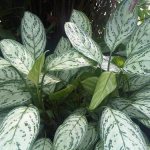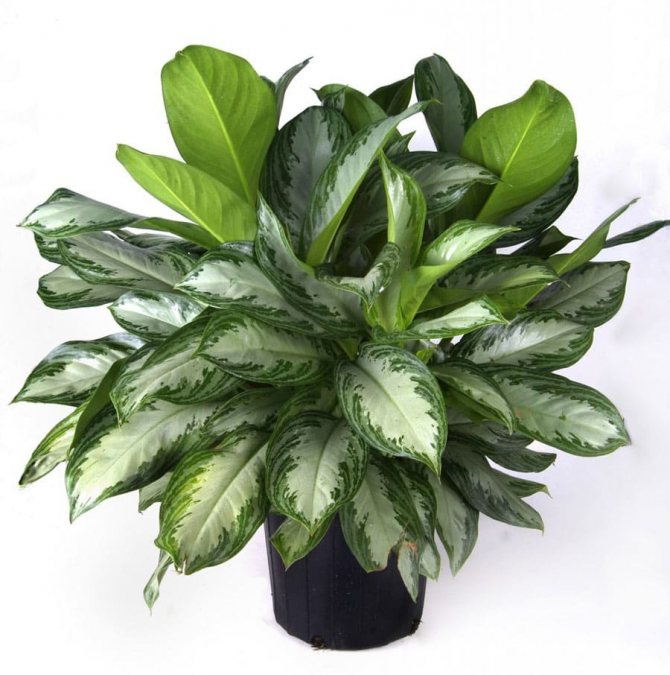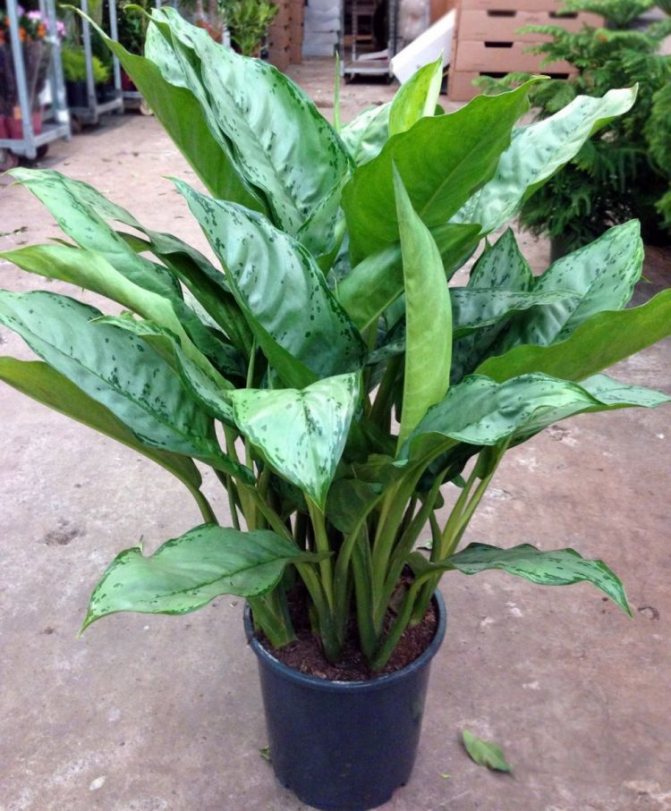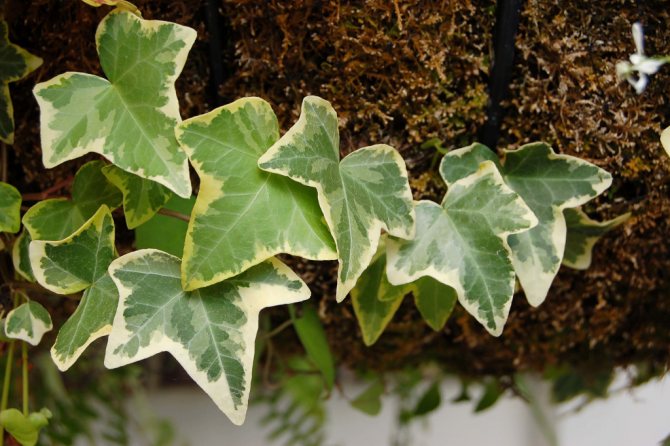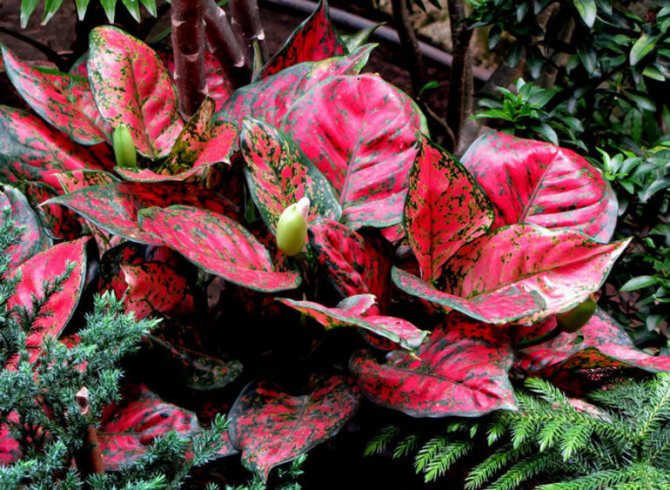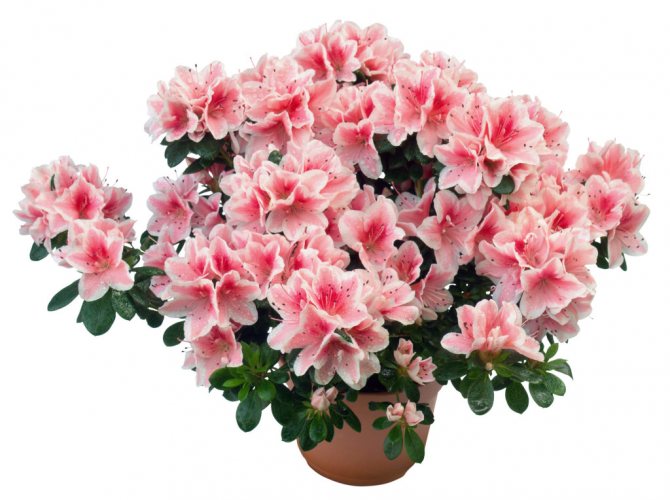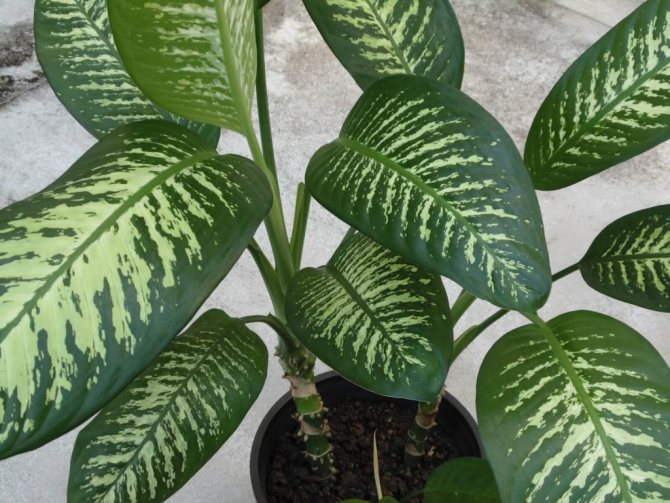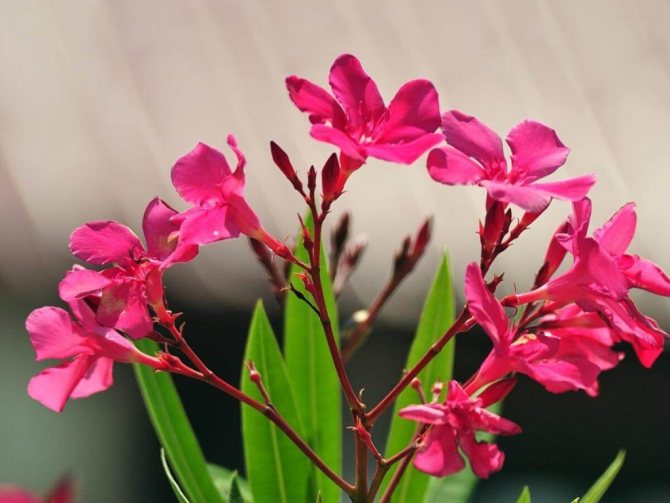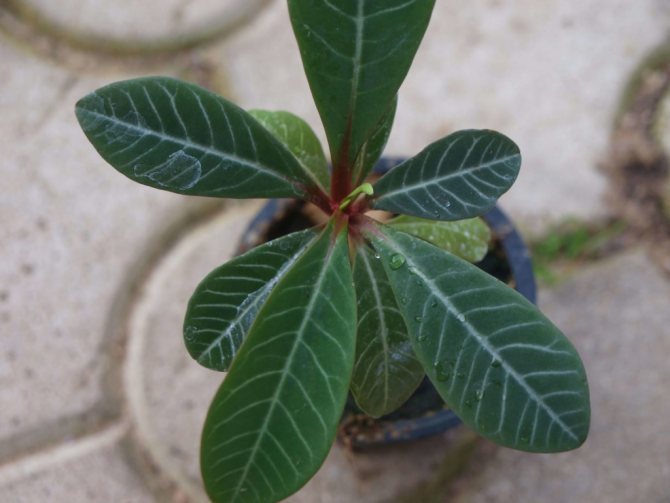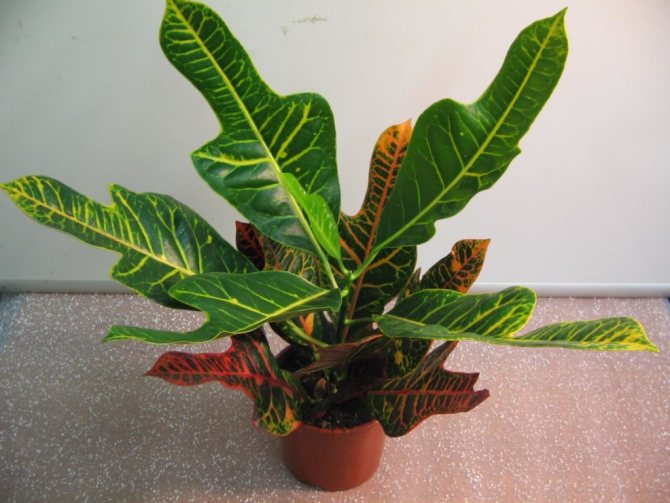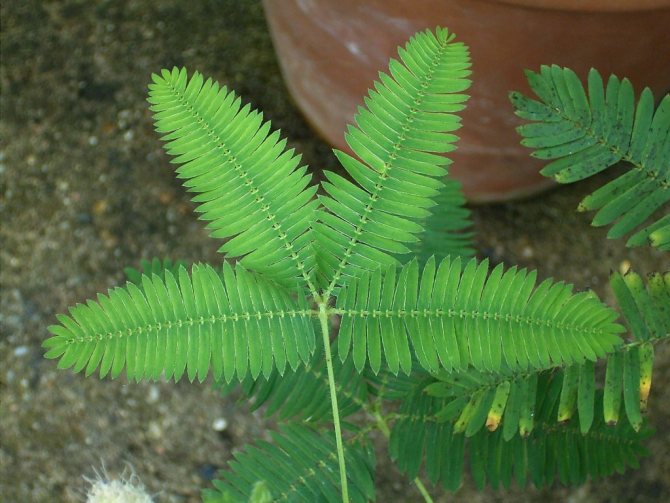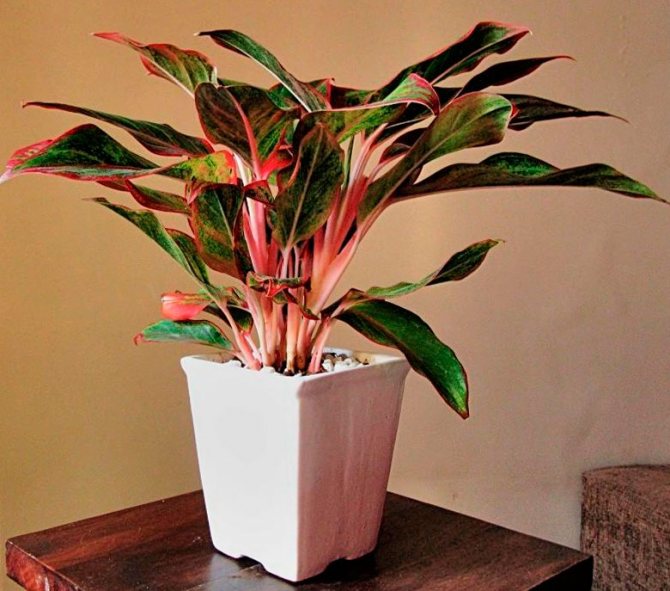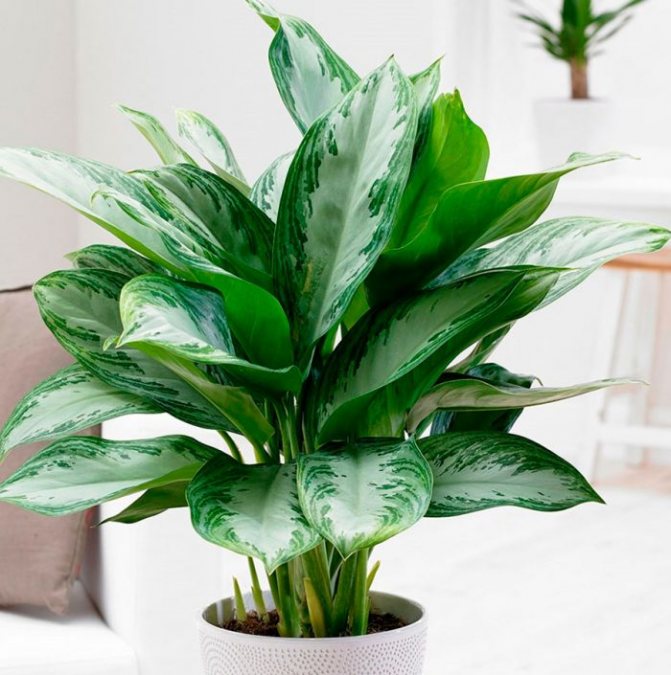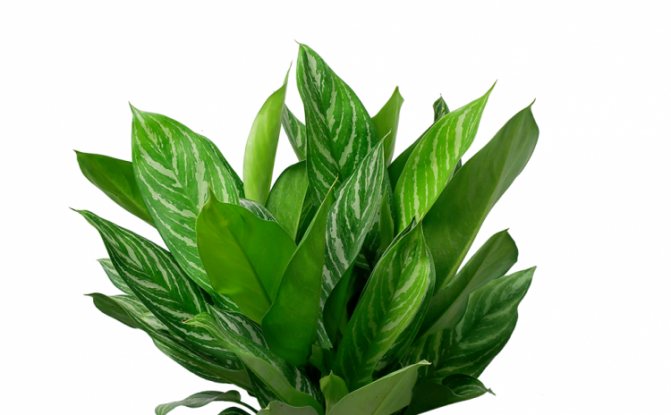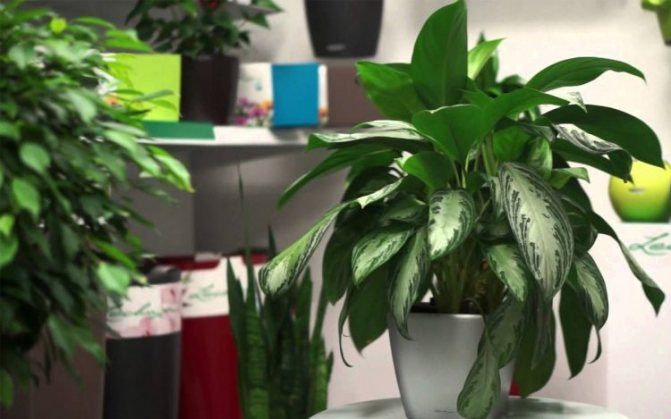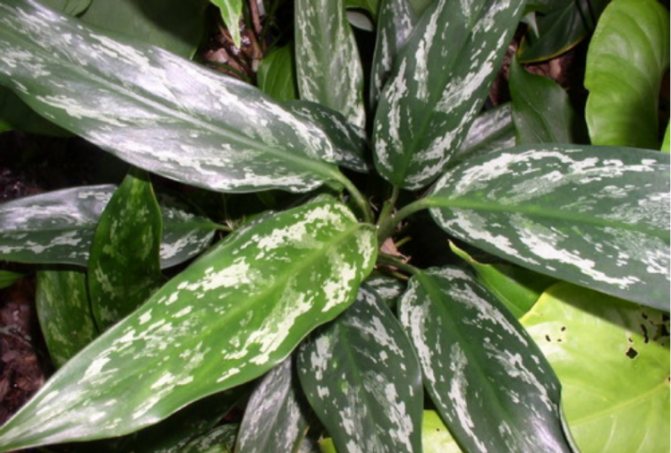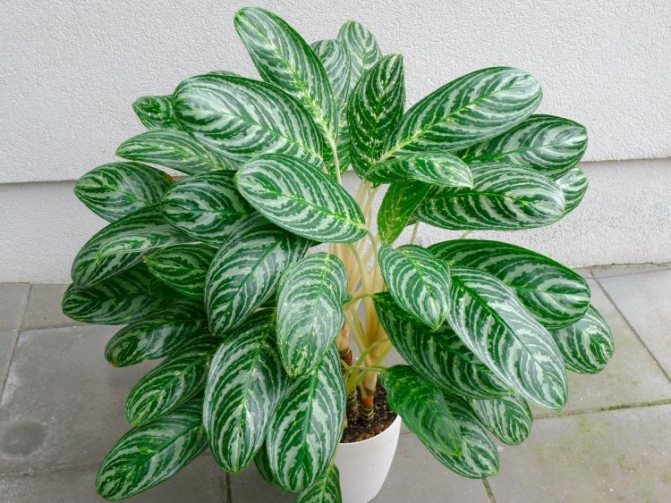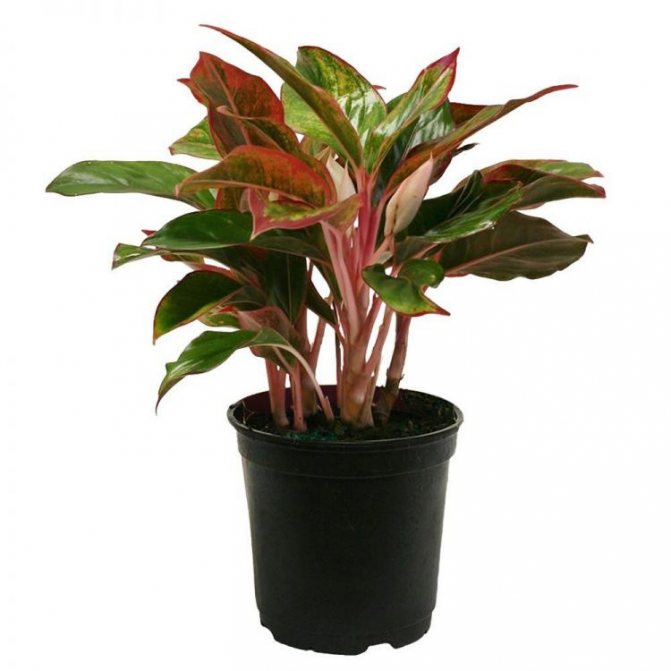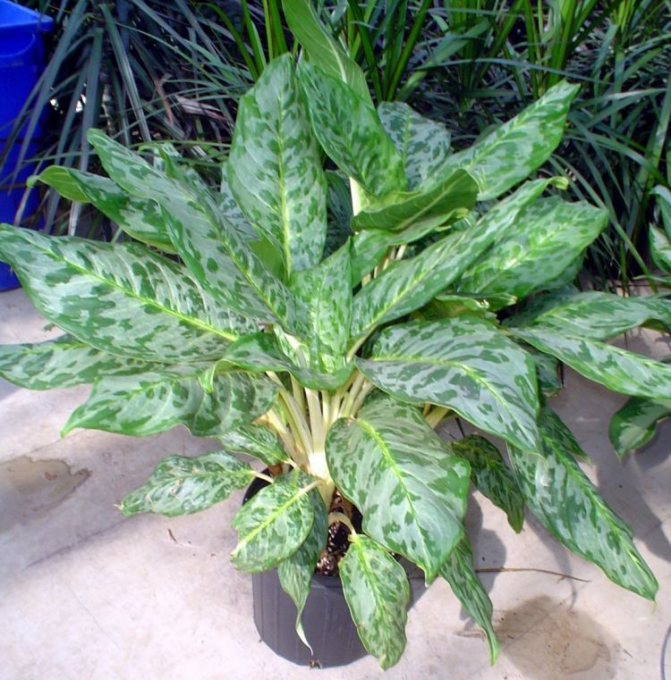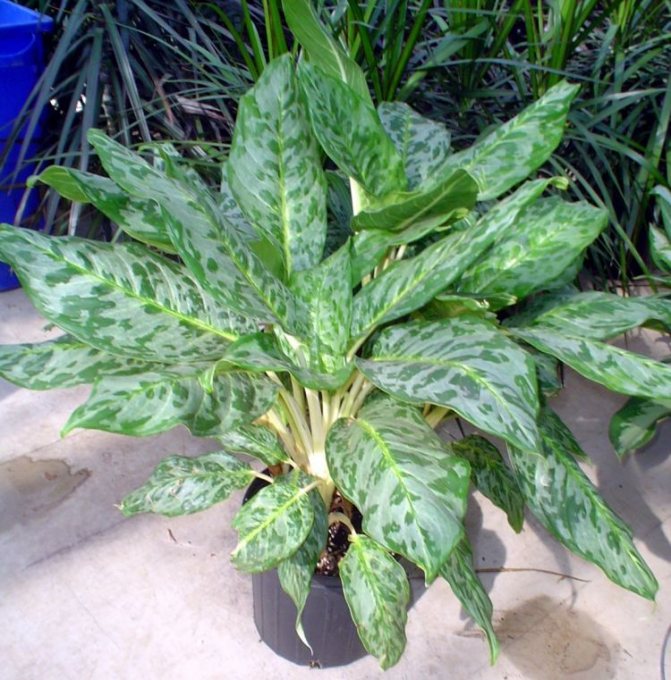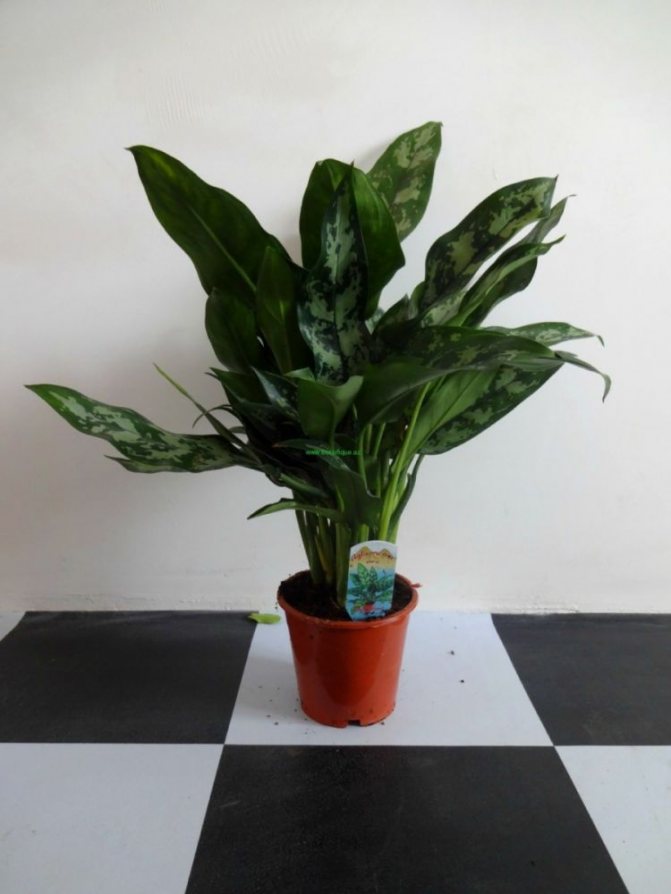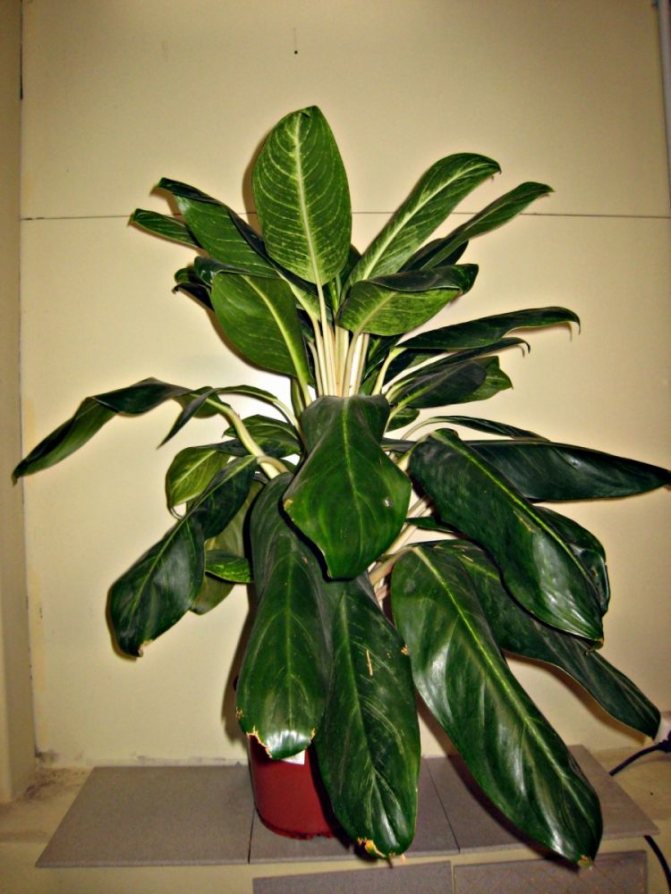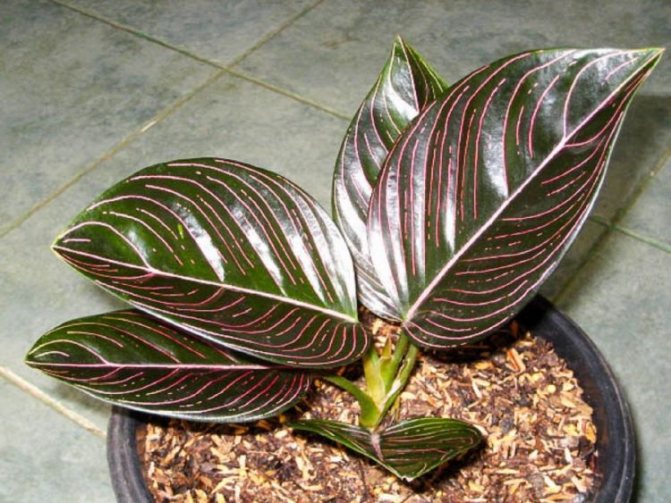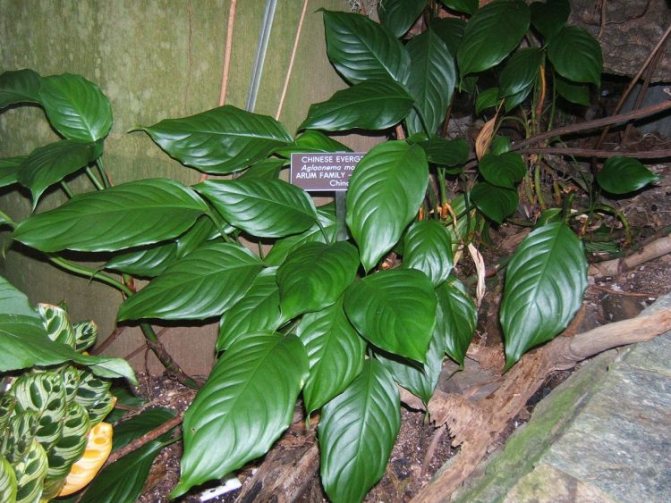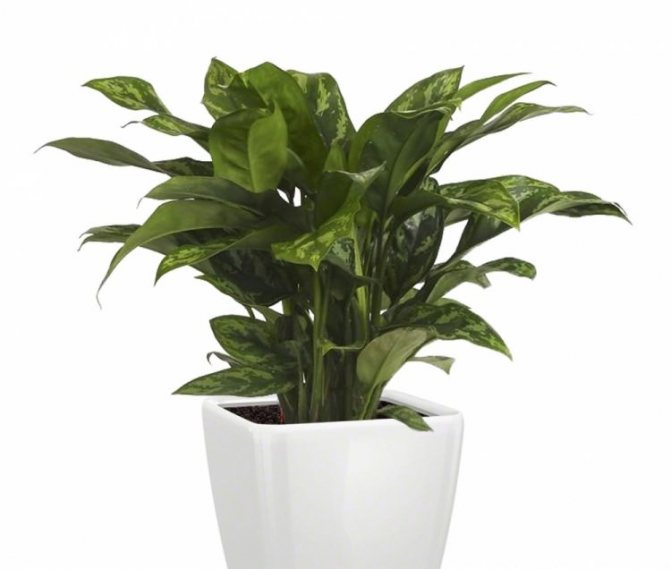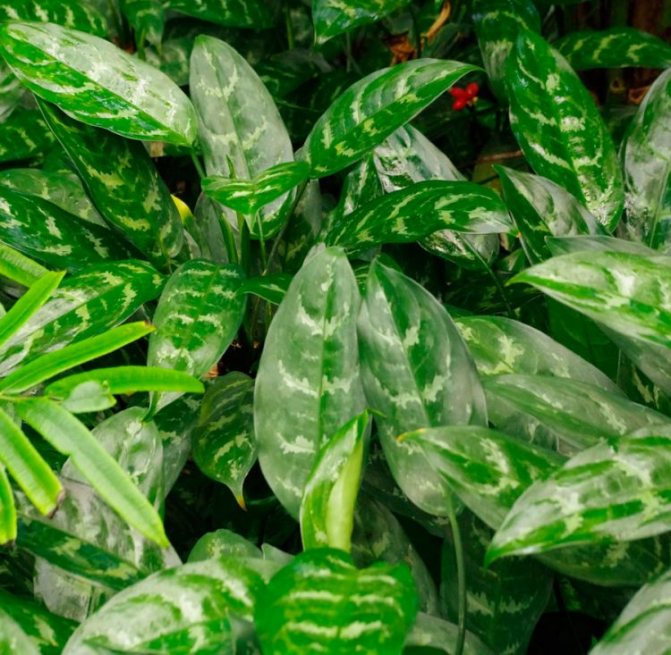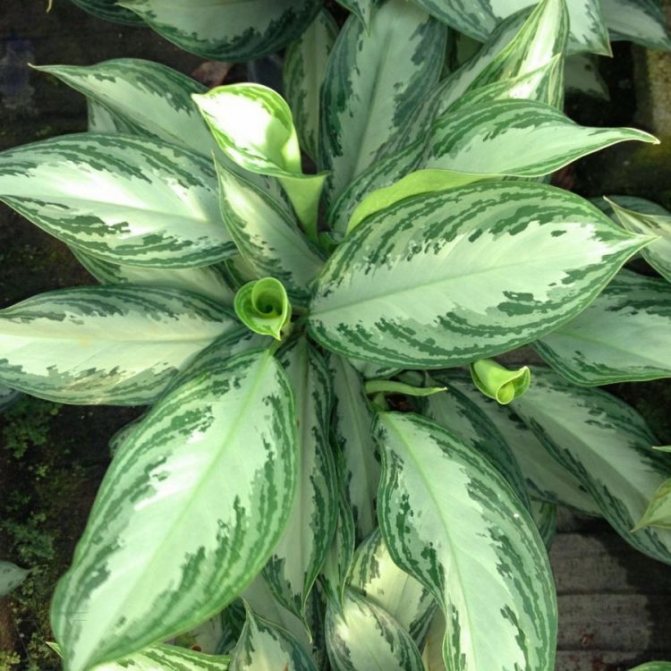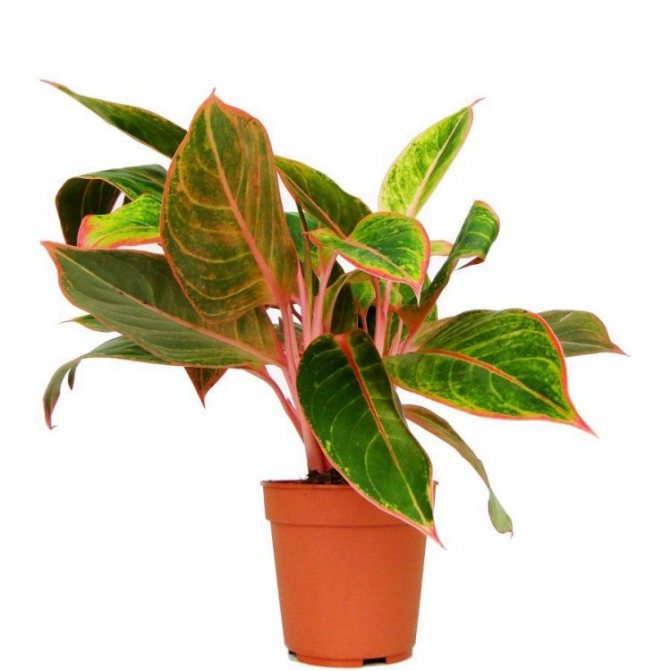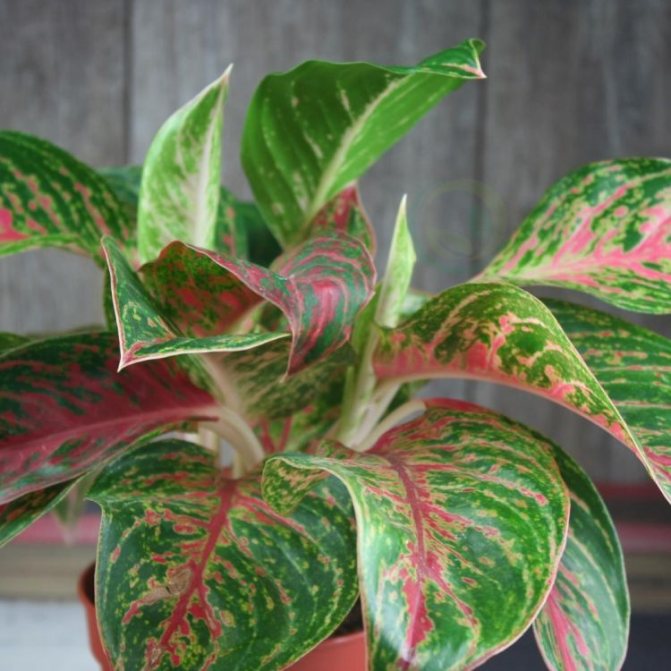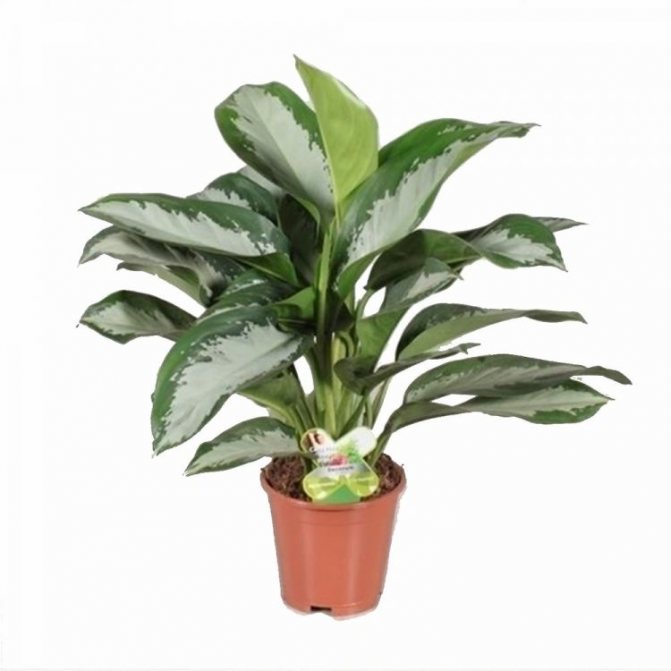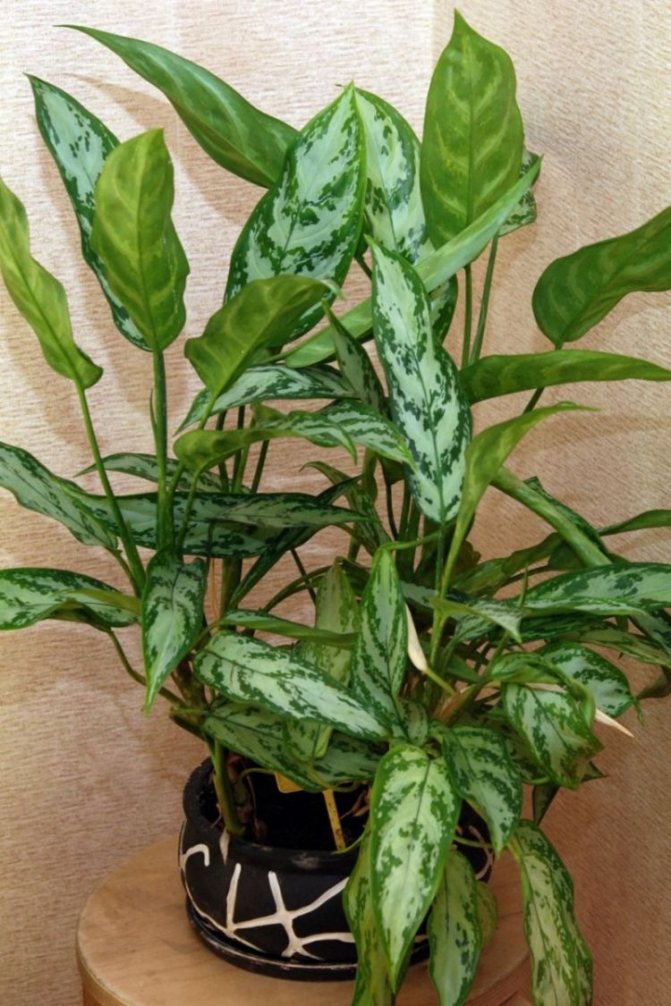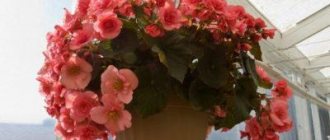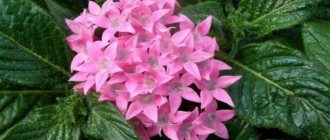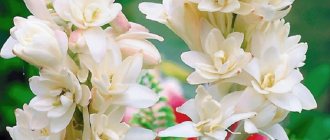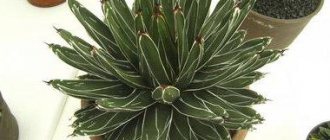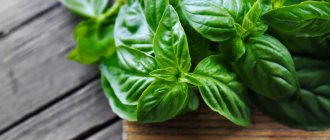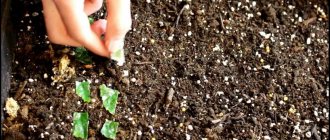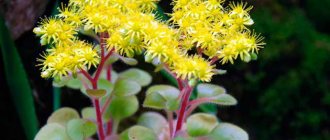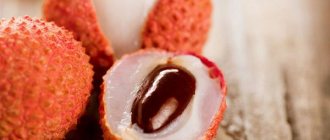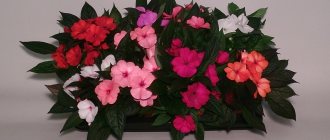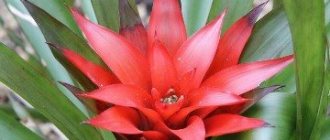Without indoor flowers, it is impossible to imagine any house and not a single office. Houseplants not only decorate the room in which they are located, but also create and maintain a special atmosphere.
It is very easy to see that flowers will grow beautifully in a house with a good aura. But in a room devoid of comfort, love and warmth, indoor plants feel terrible. This means that flowers are very sensitive to the energy of the people around them.
Today we'll talk about the signs associated with aglaonema - this is a popular houseplant native to Southeast Asia. It gained such fame not only because of its beauty, but also because of the good omens associated with it.
Photo gallery
Aglaonema photo
Aglaonema is a relative of Dieffenbachia, but differs from it in its smaller size. The more compact it is, the better it looks. Aglaonema grows slowly. A short trunk becomes noticeable only in an adult plant, gracefully drooping spear-shaped leaves reach 12-15 cm in length. Their color is varied, with scarlet, yellow, orange or silver stripes and spots. Pruning allows you to rejuvenate the plant, to give any shape to its crown.
Aglaonema loses its decorative effect only with a lack of nutrients or with prolonged hypothermia.
The most famous varieties:
- modest, with pure green leaves, natural room disinfectant;
- changeable, with variegated leaves;
- ribbed, with wider leaves, mottled with whitish spots and streaks.
Under favorable conditions and proper care, a small white or yellow flower appears on the aglaonema, after about six months red berries ripen, similar to lingonberries, with a seed that patient people can use for reproduction.
Caution: these berries are poisonous! The sap of the plant is also dangerous, causing irritation and swelling of the mucous membrane.
Due to its variegated color, this plant is used in mixed plantings: its foliage is in sharp contrast to the leaves of its neighbors.
3.Types of aglaonema:
3.1 Aglaonema changeable - Aglaonema commutatum
One of the most common species of this genus. Evergreen herbaceous perennial of small height - about 50 - 60 cm.The leaves are variegated, striped, thick, spear-shaped, shiny, the main tone is dark green, have an attractive silvery marking along the main vein, the length of the leaf plate ranges from 10 to 30 cm, width - from 4 to 10 cm. Leaves are arranged on short, erect, sometimes branched, glossy green stems, reaching two meters in height over several years. This aglaonema rarely blooms, peduncles are high - up to 20 cm, axillary flowers with a pale green veil are collected in an inflorescence - an ear, usually appear in late summer - before autumn. The flowers are small and inconspicuous, resembling small greenish-white calla lilies.
Fruit - yellow, changing color to bright red oval berry less than 1 cm in length gives the plant additional decorative effect. The plant resembles dieffenbachia in appearance and is used as an ornamental deciduous. The easy-care plant prefers loose, rich soil and abundant watering.Varieties of aglaonema changeable differ in the color of the leaves, it is worth remembering that the more variegated the variegation is, the more the plant needs light.
↑ Up,
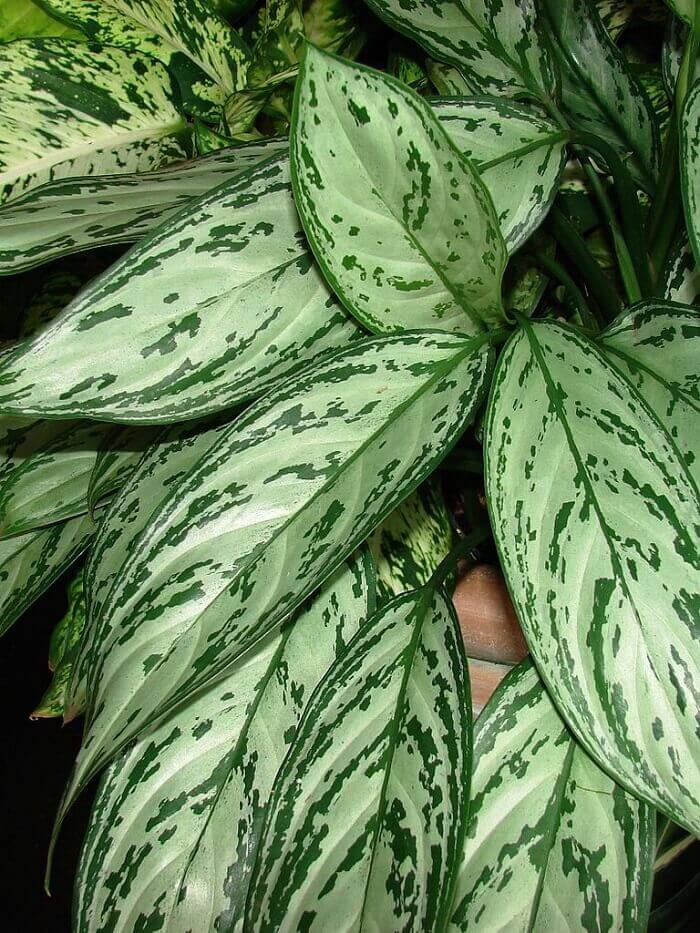
3.2. Aglaonema curly or Robelena - Aglaonema roebelenii
An evergreen perennial about 1 m high. The stems are densely covered with long, elliptical, rigid, leathery leaves with silvery-gray veins and dark green edges on short petioles. The length of the leaves ranges from 20 to 30 cm, the width is within 8 - 13 cm. It is grown mainly in greenhouses and conservatories due to its large size for the sake of variegated leaves. The flowers are relatively long, greenish and not particularly noticeable. They get more attention when they turn into red berries. Aglaonema curly requires warm conditions throughout the year and diffused light or partial shade; she does not tolerate direct sunlight.
You may also be interested in:
- Alstroemeria - flower photo, planting and care, growing in the open field and at home, description, varieties, soil composition for keeping home alstroemeria in a pot
- Rejuvenated - photo, planting and care in the open field, varieties of a stone rose, growing a flower at home, flowering time of a plant, composition of soil for keeping in a pot, description of a plant
- Saintpaulia - photo, violet varieties, home care, plant propagation, soil for growing indoor flowers, diseases and pests, transplantation, fertilization, watering
- Verbena - photo of a flower, planting and care in the open field, growing seedlings, a plant in a flower bed, medicinal properties, description, content in a pot and in a pots, height
- Monarda - photo, planting and care in the open field, medicinal properties of a flower, description of a plant, growing from seeds, use of essential oil, varieties, caring for a perennial at home, flowering time
↑ Up,
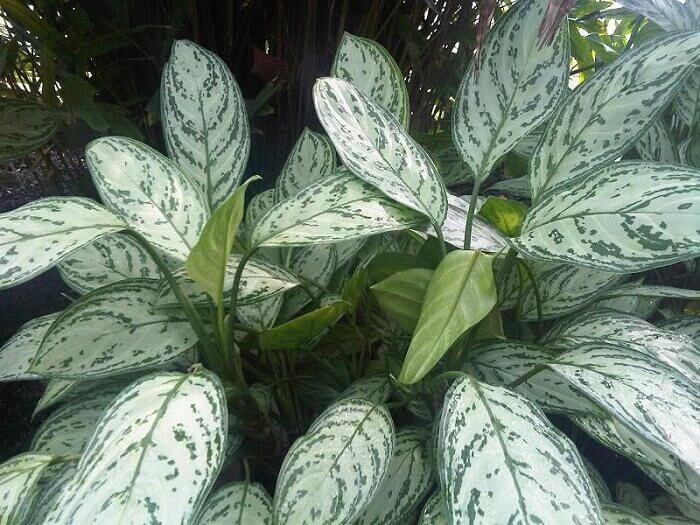

3.3 Aglaonema Maria
Evergreen decorative leafy plant with oblong dark green leaves covered with light green transverse stripes. Differs in resistance to low light levels. It successfully tolerates short droughts and is successfully grown under artificial illumination.
↑ Up,
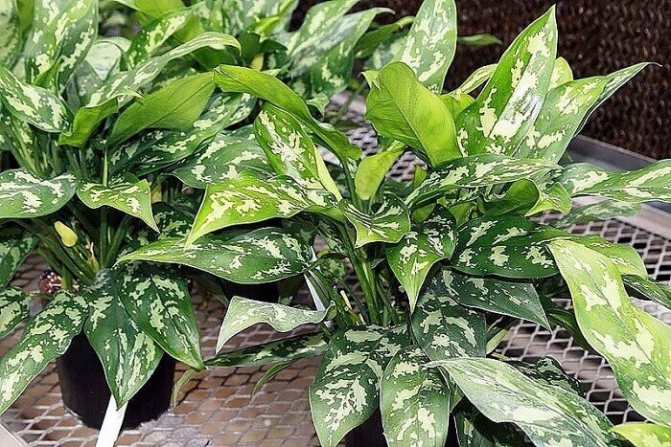

3.4 Aglaonema Silver Bay
A large plant - a bush reaches 1 m in height. The large leaves of this plant are distinguished by a light green or silvery gray base tone and a darker edging of the leaf plates. This plant tolerates a wide range of temperature conditions and grows well under artificial light. Aglaonema Silver Bay tolerates both short-term droughts and bays.
↑ Up,
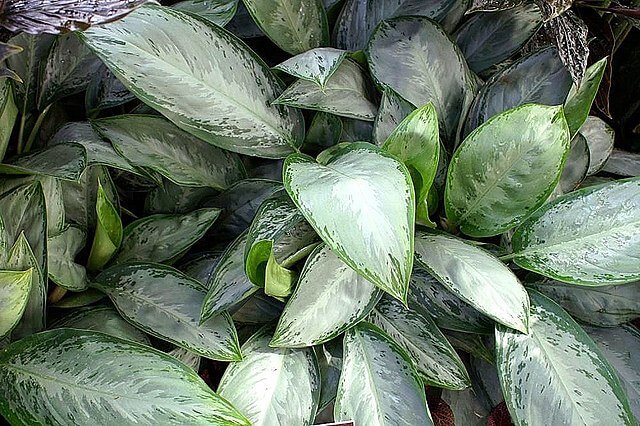

3.5 Aglaonema Crete
This variety is also called "red aglaonema" because of the distinctive color of the leaves - they have salmon or pink edging and spots of the same color, scattered over the leaf blades. The underside of the leaf plates is also colored pink. Very stylish, elegant plant. Aglaonema Crete does not like bright lighting.
↑ Up,
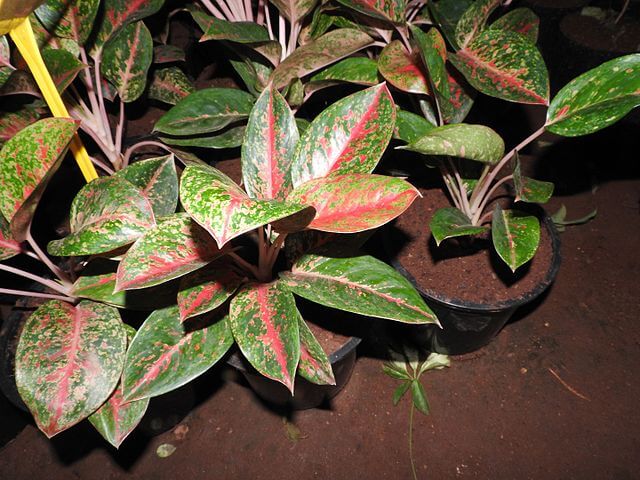

3.6. Aglaonema painted tricolor - Aglaonema pictum
Spectacular ornamental, slow-growing subtropical houseplant. This variety has large, glossy, narrow - oval leaves. The leaf blades are dark green with lighter green and almost white spots, reminiscent of camouflage. With age, these flowers form sturdy stems covered with light brown bark. Even adult specimens remain compact and often do not exceed a height of 30 cm.
↑ Up,
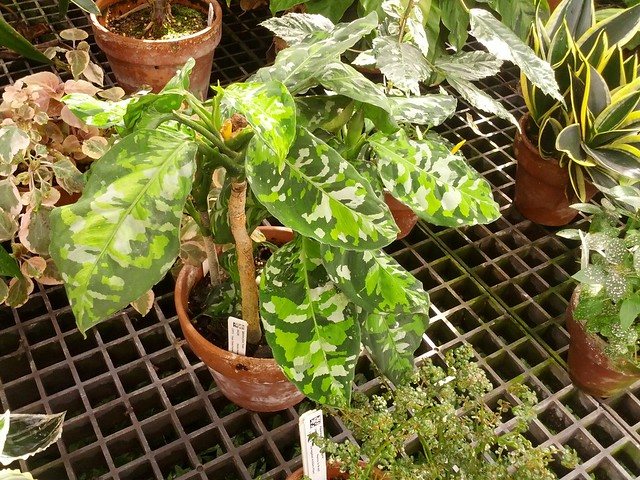

3.7. Aglaonema pseudobracteatum - Aglaonema pseudobracteatum
Narrow-leaved aglaonema with dark green, glossy, pointed leaves on long, relatively thin petioles.The surface of the leaf blades is abundantly covered with light green and white spots, and the central vein is highlighted in green.
↑ Up,
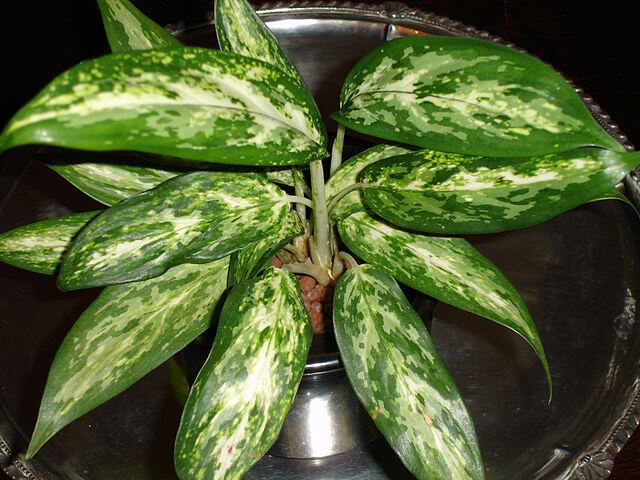

3.8. Aglaonema ribbed - Aglaonema costatum
Slow growing, large-leaved bushes up to 60 cm high with oblong, pointed leaves up to 20 cm long. Leaf blades are emerald green or very dark, almost black, the central leaf vein is highlighted in a lighter shade.
↑ Up,
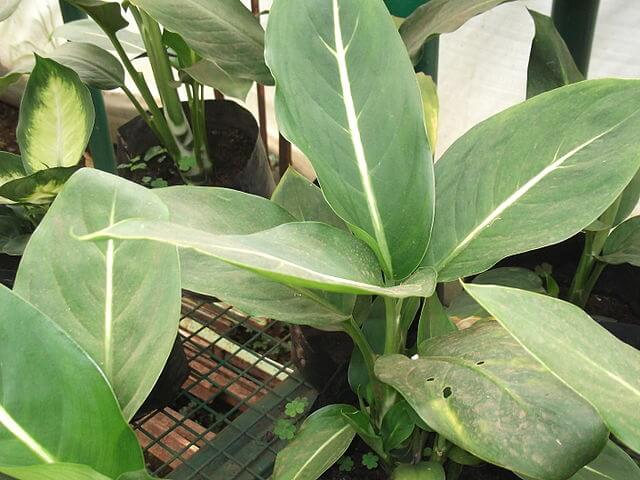

3.9. Aglaonema oblong-leaved - Aglaonema marantifolium
Perennial evergreens with oblong - elliptical glossy leaves on long, thin petioles. The leaf blades are dark green, with small light green and transverse stripes. Plants are tall and can grow to a height of 60 cm.
↑ Up,
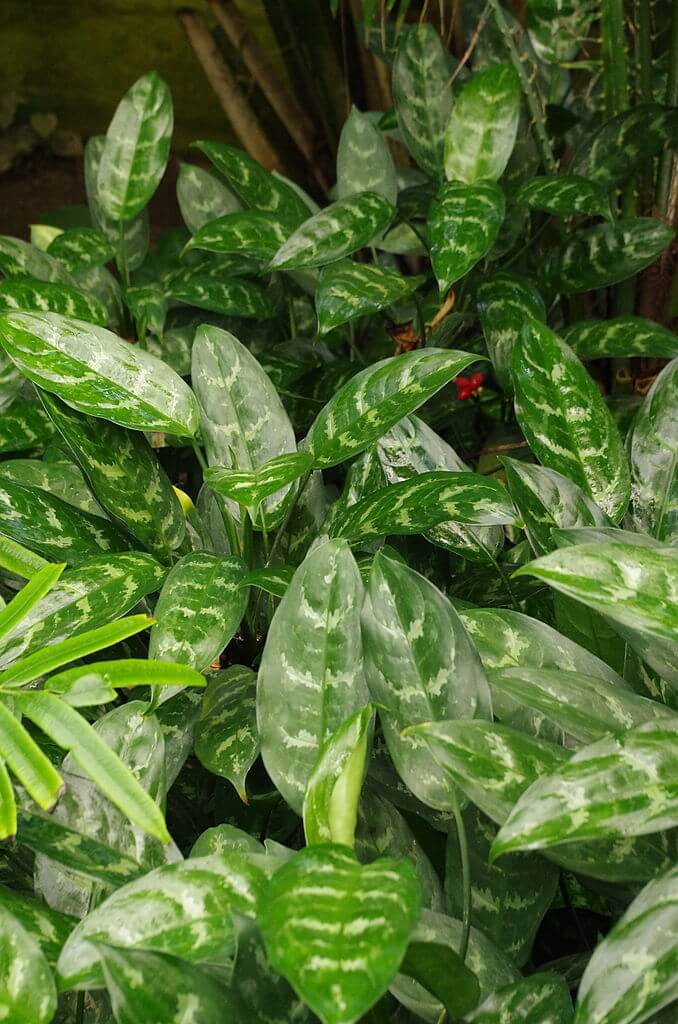

3.10 Aglaonema modest or moderate, Aglaonema modestum
These plants are considered one of the most useful in the house - they are able to effectively cleanse the polluted atmosphere from many harmful impurities. In addition to its benefits, this plant surprises with its attractive appearance - it has wide - lanceolate, glossy, whole-edged leaves, painted in a dark green color. Variegated varieties are distinguished by the presence of light green and white spots and stripes.
↑ Up,
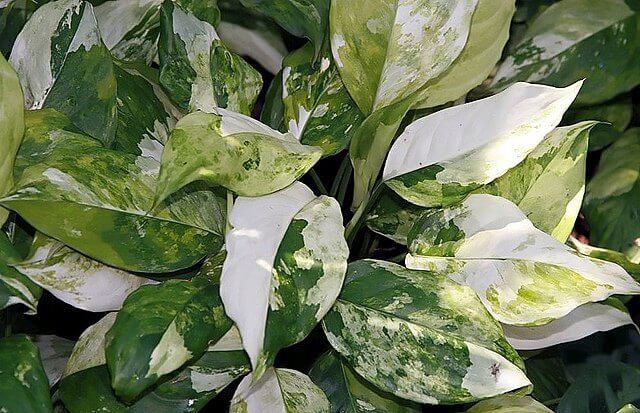

Temperature and humidity
The optimum temperature for aglaonema in winter is not lower than +15 ° C, in summer - not higher than +25 ° C. This southerner does not tolerate drafts, sudden changes in temperature and dry air. How many can boast that they have tropical humidity in their apartment? That's right, this is not always useful for a person, but plants that were taken out of the tropics die in rooms where the air is dried by an air conditioner.
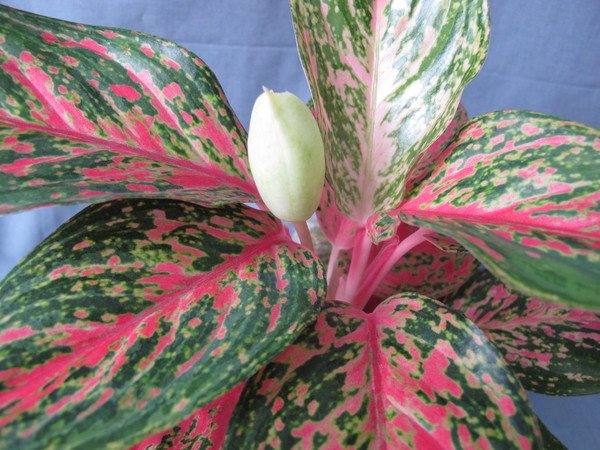

In summer, aglaonema should be sprayed daily with filtered (or boiled) water, and the leaves should be cleaned of dust and traces of calcium with a soft, damp sponge.
Aglaonema does not like it when her leaves are treated with a spray or gloss solution. In winter, it is not recommended to spray it; during the heating season, move the pot away from the radiator, place a container with water next to it.
Folk beliefs
In Malaysia and India - in the homeland of Aglaonema - the plant is considered a flower of luck... This belief emerged from the following story. One man had an aglaonema in the garden. Once a man saw dew drops on her leaves, which were laid out in the form of numbers, and bought a lottery ticket with such a combination. The ticket was won and the story of Aglaonema, which brings good luck, spread all over the world.
Of course, aglaonema will bring good luck to your home, and will also attract well-being to the owner's house: the plant purifies the air in the room where it is.
Why does it bloom?
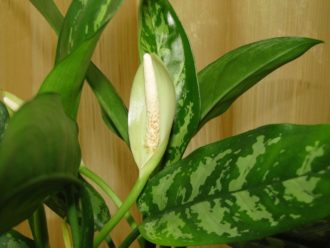

Aglaonema is very sensitive, and its leaves will turn yellow not only if placed in the wrong place, but also if it grows in a house with a heavy atmosphere.
Aglaonema will wither, turn yellow and stop growing and blooming in a house whose owners often quarrel and make scandals. And, on the contrary, if aglaonema has bloomed, it means that happy times await your family hearth.
What do they say about the variety Maria?
Aglaonema of the Maria variety has leaves of a calm green color. This type of aglaonema is acquired in dysfunctional families, as it brings peace of mind to the house, makes the environment comfortable.
What will other species bring to the owners?
- Aglaonema Okruglaya - a very beautiful flower. It has become a favorite houseplant due to its unusual color of leaves and pink stripes on them. If you put a plant in the bedroom, the feeling of love in the couple will grow stronger, the flame will reappear in the relationship, and the partners will become more liberated.
- Aglaonema Crete differs from other species in its rich red or pink color; the plant is best for lovers who want to strengthen their relationship.
- Aglaonema with unusual coloration - on the leaves of which there is a white stripe or light green spots - will help to attract good luck to your side and improve your material condition.
What to feed?
From March to August, aglaonema experiences a period of active growth, when it requires abundant watering and feeding with complex (organomineral) fertilizers every 2 weeks.
In September, the plant goes on winter rest until February. Top dressing is canceled, watering - no more than once a week, or even less often if the room is cool.
In summer, the plant asks to drink every other day. The soil in the pot should be constantly moist, but be careful when watering.
From overflow and stagnation of water, roots die and leaves wither. If overflowed, move the flower to a warmer place, let the ground dry 2 cm deep.
It is better to water from above, wait until the water seeps into the pan, then pour out the excess.
In winter, watering is moderate, if necessary. Let the top layer of the substrate dry 1-2 cm.
In the spring-summer period, watering is combined with fertilizing with liquid complex fertilizer for indoor decorative deciduous plants.
External signs
Fleshy stem and oblong-rounded leaves, green or green-red, often variegated, with a depressed central vein.
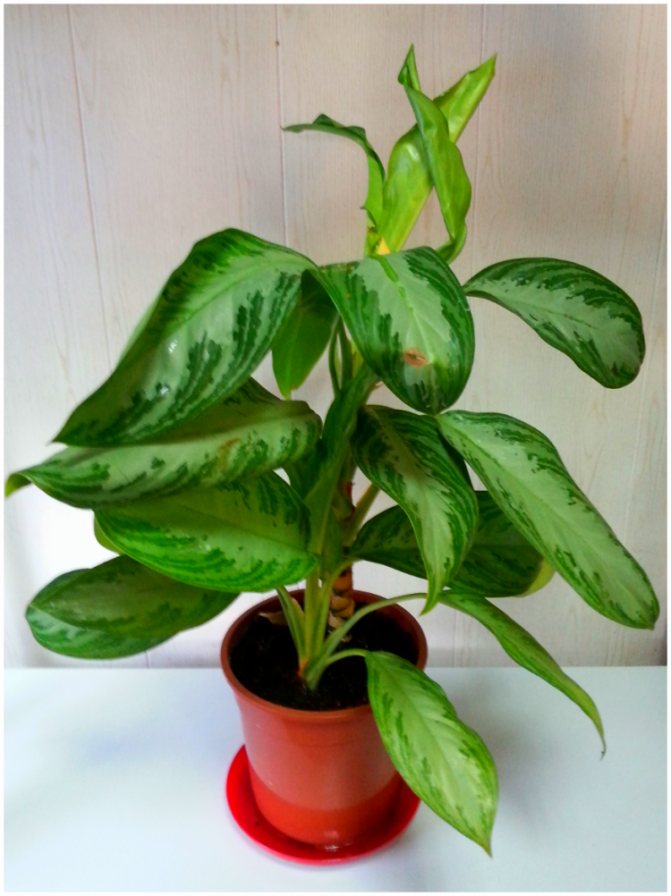

Beautiful inflorescences up to 6 centimeters in length and up to one in diameter. The white or greenish aglaonema flower contrasts perfectly with the overall color scheme of the bush.
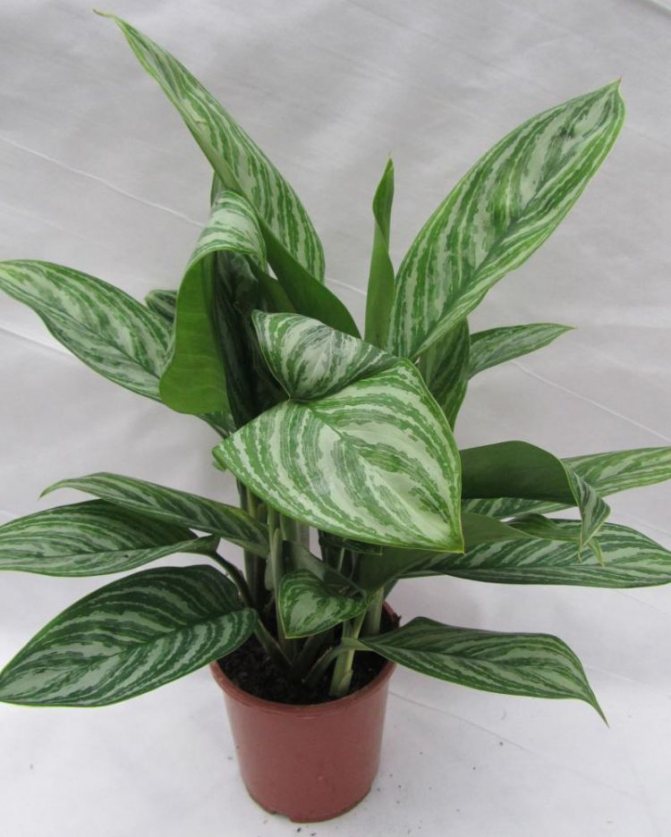

Orange-ruby fruits with one seed ripen on average for 7 months and are similar to dogwood fruits.
Soil for a flower
A properly selected potting mix allows aglaonema to remain decorative for a long time. The substrate should be loose and nutritious.
Another secret of caring for aglaonema at home: a ready-made mixture for bulbous, saintpaulias and azaleas is suitable for the flower. If you are preparing the soil yourself, take in equal amounts:
- sod land;
- peat;
- leaf humus;
- coarse river sand;
- perlite.
The soil is acidic due to peat and humus. Add crushed charcoal and brick chips. Aglaonema doesn't mind hydroponics.
Growing aglaonema from seeds
Aglaonema seeds photo
The plant is self-pollinated. Abundant fruiting facilitates seed propagation. Harvest the fruits when they are fully ripe - they will have an intense bright color that remains on the skin when touched. Use fresh seeds for sowing. Before planting, remove the seeds from the fruit, rinse them from the pulp, immerse them in moist sphagnum by 1-1.5 cm.Cover the crops with foil, maintain high humidity and temperature within 20-26 ° C.
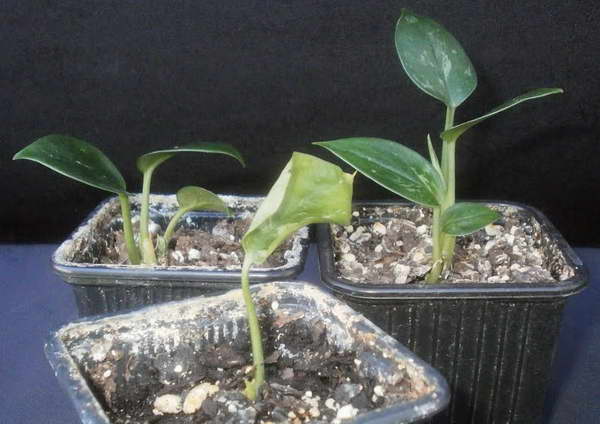

Aglaonema from seed photos of seedlings
Fresh seeds sprout in 20-25 days, sometimes the process takes about 3 months. When a leaf rosette with a diameter of 5-7 cm is formed, the plant is dived and transplanted into a pot with universal soil, peat, perlite in equal proportions. You can add charcoal or small pieces of steamed bark.
Plant transplant
Aglaonema is not growing fast enough to change its "home" every year. But once every 2 years, in spring or summer, it needs to be transplanted. Aglaonema has a caustic sap, so carry out the transplant with rubber gloves.
Interesting: if the roots of a plant are confined to a cramped pot, it gives a stronger growth of leaves.
Therefore, it is unwise to choose a large pot right away. For growing, use a pot that has a circumference one third less than the projection of the leaves. Many people love the glazed clay pots that are now flooding the market. However, they are more likely to promote water stagnation than conventional plastic ones. In addition, a catchy ornamental deciduous plant looks more elegant in a simple monochromatic pot.
sunlight
The plant is warm and light-requiring, but the direct rays of the sun are poorly tolerated.In the light, the variegated color of the leaves is perfectly manifested, but partial shade will be optimally comfortable. Shade is more suitable for varieties that do not have variegation.
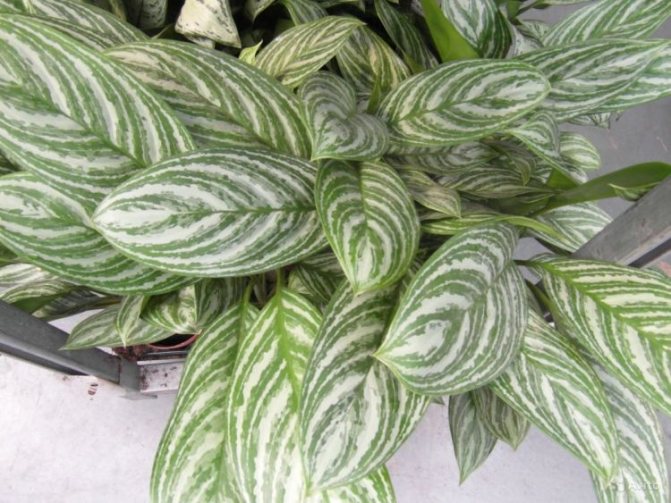

It is necessary to ensure that the temperature does not fall below +16, and +25 degrees is considered the maximum for a comfortable life of room aglaonema.
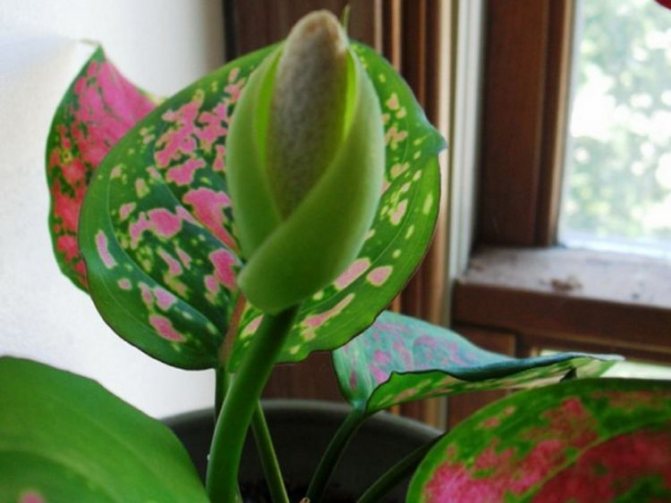

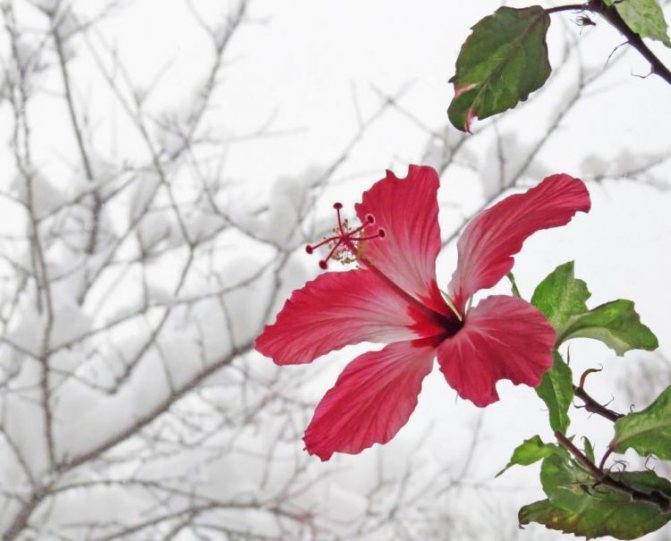

Hibiscus - seedling selection, care, reproduction and advice on watering the plant. 110 photos and video review of the flower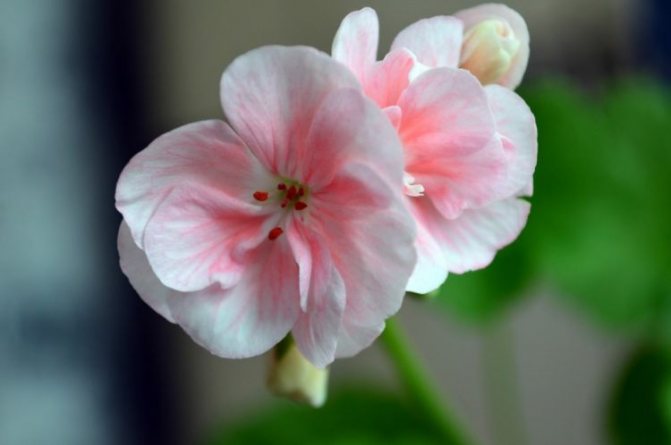

Geranium - secrets of growing, options for use and features of use in decor (95 photos and videos)
- Ahimenes: types, planting, care, reproduction and secrets of use in the garden and in the interior (115 photos)
Brought him home
What do we do with a flower when we bring it to permanent residence from the store? Once again, we carefully examine, remove problem leaves, look for external manifestations of diseases. Most often, a warm shower is enough for the plant, after which it rests in the shade away from drafts. If you have a rich collection of rare and expensive indoor plants, you shouldn't immediately introduce them to a beginner.
Let him stand alone for a week, in a kind of quarantine. If there are no warning signs, assign it to a permanent place. We decide the question of transplanting depending on the condition of the soil and the pot: check in advance with the store when the plant was transplanted into fresh soil. You can read about caring for the popular hybrid Aglaonema Maria here
Spread
Aglaonema, as a lover of soil with a high moisture content, can often be found in tropical forests, as well as along the banks of rivers and streams of Southeast Asia, India, and China.
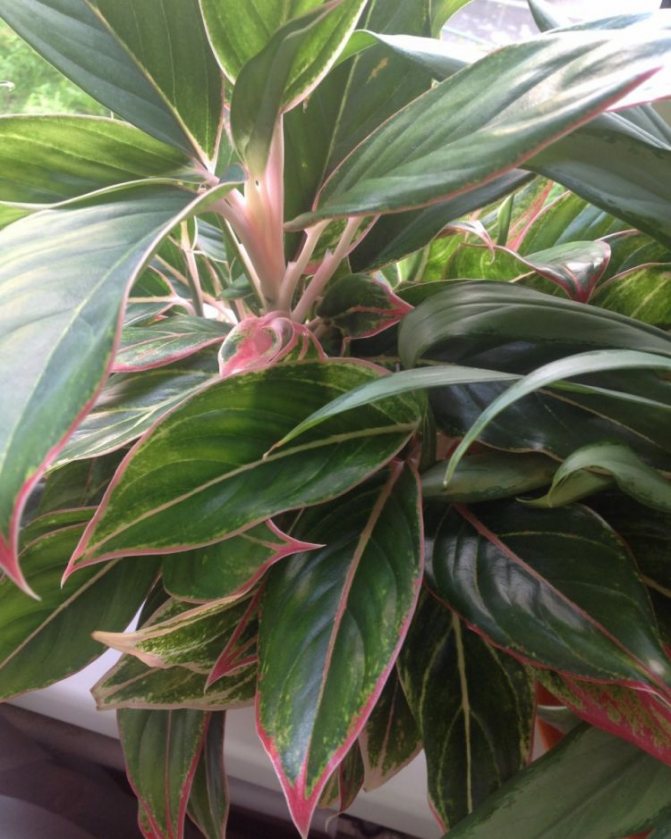

And since the shrub is very beautiful, it has become a frequent inhabitant of window sills and greenhouses.
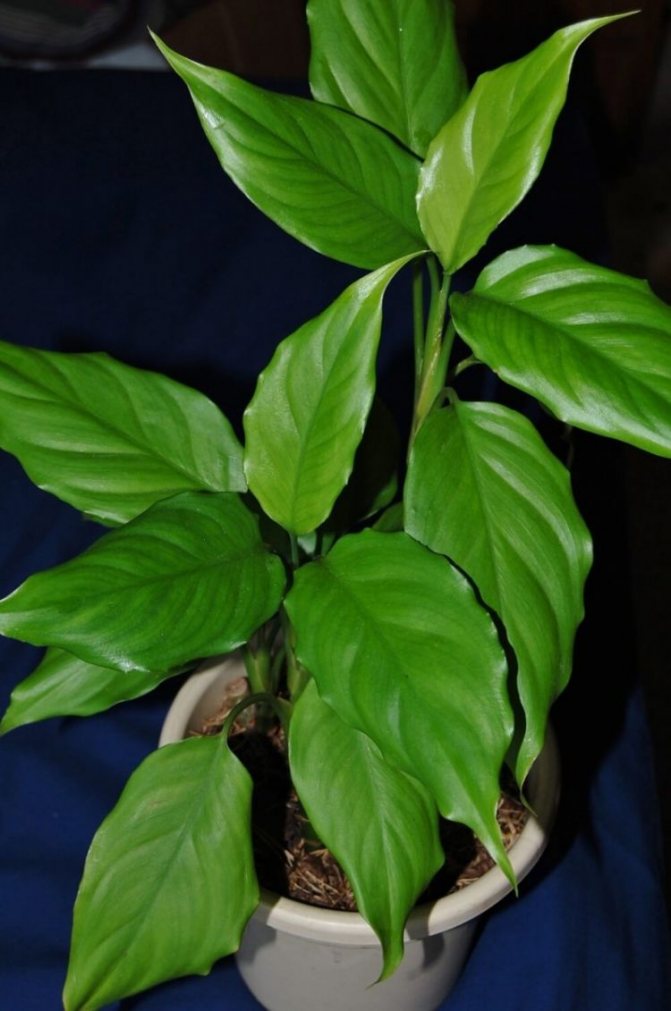

How to reproduce?
One of the most common ways of reproduction of aglaonema at home is separation in the spring during the transplantation of young underground shoots. Make sure each part has developed roots. Keep the planted shoots warm (+21 ° C) until they take over and begin to grow confidently.
Cuttings
Aglaonema also reproduces successfully by cuttings. The lower part of a strong and healthy stem is suitable for this, which is cut almost at the level of the soil. Roots on cuttings emerge from dormant buds. The grafting technique includes the following manipulations:
- Using a sharp, disinfected knife, divide the long stem into 10-15 cm pieces.
- Cut off all the leaves from the cutting.
- Place the cuttings in a moistened mixture of peat and coarse river sand.
- Place the cuttings in a warm, not too sunny place.
- Put a plastic bag on top of the pot with the handle and air it periodically.
- In the summer, it takes 2-3 weeks for rooting, in winter it is 2 times more, but it is better not to disturb the plant during the dormant period.
When the cuttings are rooted and leaves appear, the young plants are transplanted into permanent pots.
Indoor gardening enthusiasts can also get a new plant from seeds. In ripe bright red berries, a completely germinating seed is hidden. They planted. Watered. They waited. And you have a young aglaoneman!
The berries are poisonous, so you need to get the seeds with gloves.
Aglaonema breeding methods
The plant can be propagated by seed, cuttings or root division. Each method has its own characteristics of breeding.
Seed reproduction
Seeds are harvested for multiplication when they are easily removed from the fruit. You need to plant them in the soil immediately in order to get good germination.
The seed propagation procedure looks like this:
- Fill the flat boxes with peat mixed with river sand. All components must be taken in the same proportion.
- The seeds are placed in moist soil to a depth of 1.5 centimeters.
- Cover the container with a glass or bag on top.
- Spray the soil with a spray bottle every two or three days.
- With proper care, the first shoots will appear in three months.
- As soon as two or more leaves appear, the seedlings can be planted in separate pots.
Diseases. Table
Even hardy plants such as aglaonema suffer from adverse external factors and diseases.
| Problem | Cause | How to fight | Prophylaxis |
| Shriveled leaves with dry brown tips | Dry air | Remove deformed areas | • Spray regularly. • Place a container with water next to it |
| • Leaves curl and dry edges • Gray spots on leaves, oily bloom | Hypothermia, drafts | Remove deformed leaves | Move to a warmer place without drafts |
| Pale yellow spots on the leaves | Sunburn | Remove damaged leaves | Rearrange the plant in the shade, spray with water |
| Weak growth, brown edges of the leaf plate | Watering with cold hard water | Drizzle with softened water at room temperature | • Defend water for irrigation for at least a day. • Precipitate calcium with citric or oxalic acid (0.2 g per 10 liters of water) |
| Leaves turn yellow | • Too cold and humid (in winter) • Not enough power | • Remove non-viable leaves. • Move to a warmer place, let the soil dry. • Feed with organic fertilizer | • For the winter, put in a moderately warm place. • Feed regularly in the spring and summer |
| Young leaves are small and pale | • Lack of nutrients. • Roots are too cramped in the pot | • Feed the plant with complex liquid fertilizer for decorative deciduous plants. • Transplant into a larger pot | Fertilize regularly from March to September |
| The leaf plate is brittle and dry | Hot and dry | Spray and transfer to shade | • Shade from direct sun. • Water and spray more often |
| Gray bloom on leaves (gray rot) | • Too cold and humid. • Water stagnates in the pot. • The room is poorly ventilated | Remove affected parts | • Transfer to a warmer place. • Dry the soil in the pot. • Ventilate the room regularly |
Watering
Since the plant has a native tropic environment, it accordingly loves moisture very much. Therefore, it is impossible to allow the earthen coma to be very dry, and in the summer it is desirable that it be always moist.
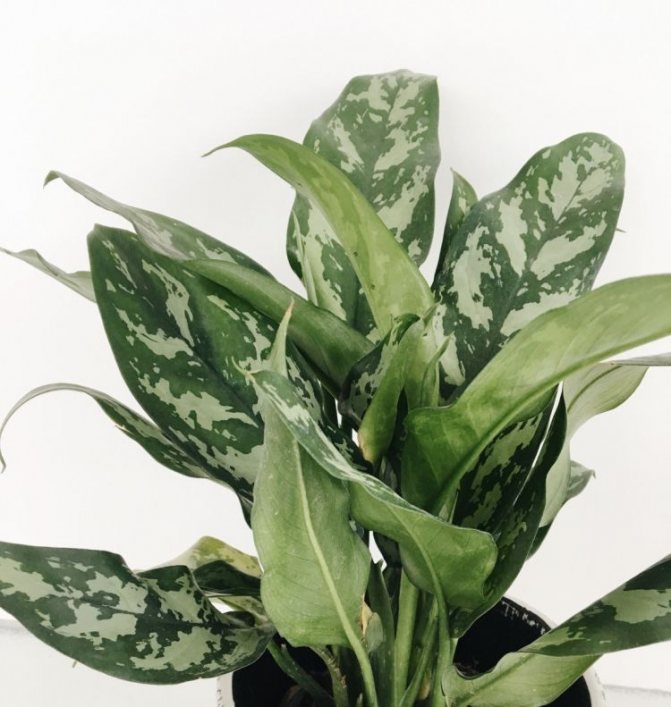

It is desirable that the water for irrigation and spraying be higher than or equal to the room temperature and must be softened.
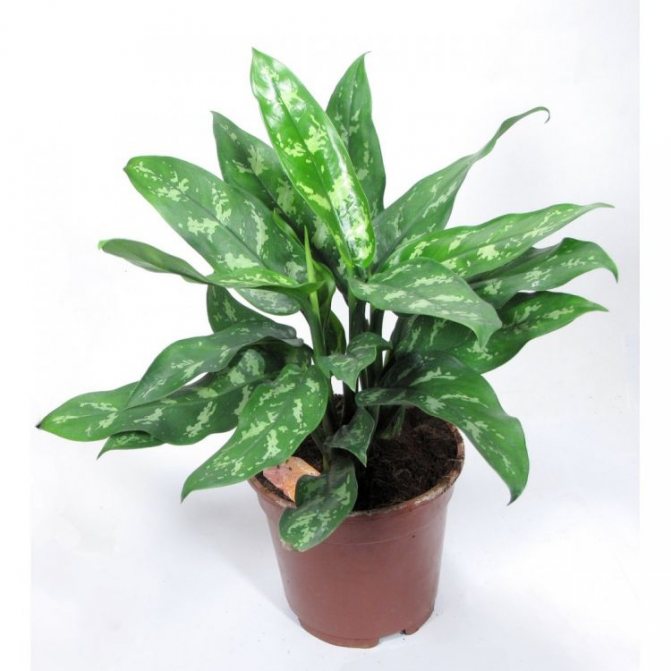

Pests. Table
Of the pests, aglaonema is affected by spider mites, mealybugs, aphids and scale insects.
| Pests | Manifestations | Fight |
| Mealybug | White fibrous formations appeared under the leaves and in the leaf axils | • Remove the worms with a cotton swab moistened with alcohol. • Treat the plant with an insecticide intended for home use |
| Shields | • On the leaves, speckled yellow spots, unusual for the variety. • Brown round shields are visible on the underside of the leaf. • Sticky bloom on the leaves | • Remove the shield with cotton wool and alcohol. • Treat the plant with insecticide |
| Spider mite | • On the underside of the leaf and in the leaf axils there is a thin cobweb and microscopic insects in it. • The leaf plate is covered with yellow dots. • In advanced cases, the leaves fall off | • Wash off pests in the shower. • Treat with acaricide according to the instructions. • Spray the plant regularly and humidify the air around it |
| Greenhouse aphid | • Leaves are shriveled, dry out. • Colony of small green insects on the stems | • Rinse the plant with warm water. • Treat with insecticide |
Aeration and moisture
The air must also be humid, and in summer the plant must be sprayed and it is better to do this in the evening, so as not to "burn" the leaves.
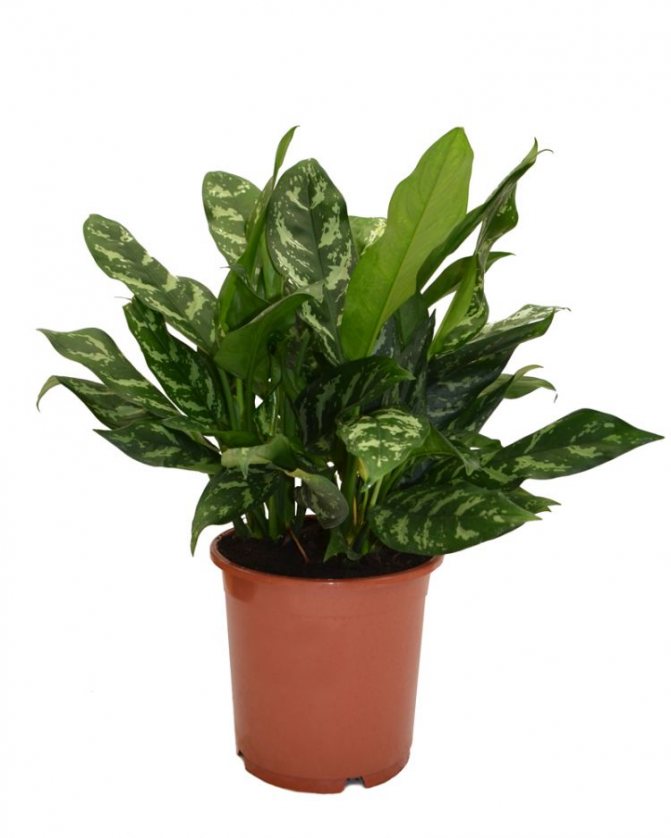

To create the most humid environment, you can put a pot with aglaonema in a tray with damp pebbles or keep a "plate with water" near it.
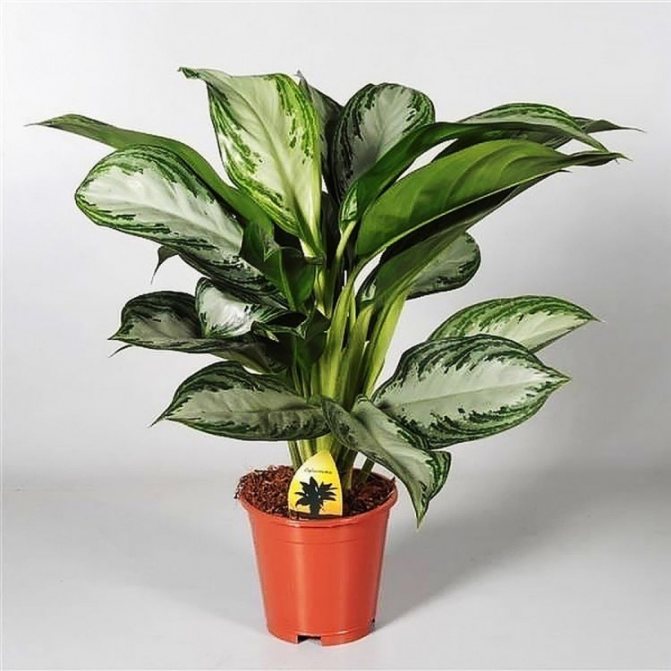

It is important to monitor the absence of drafts, as they are detrimental to the plant.
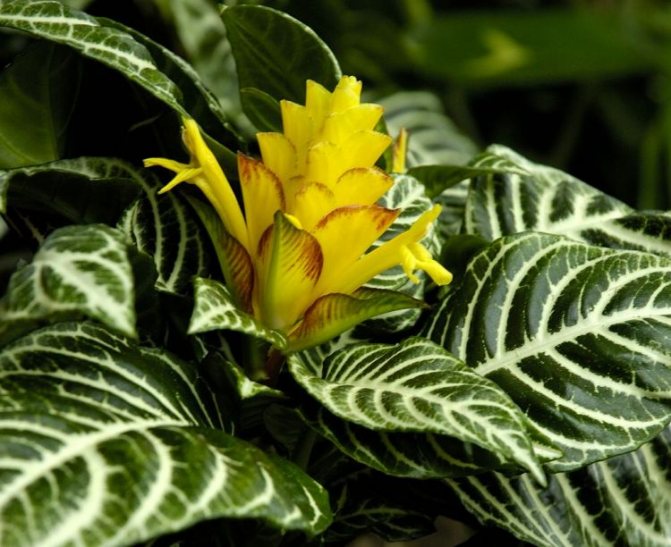

Afelandra - growing ornamental plants and an overview of beautiful flower applications (105 photos and videos)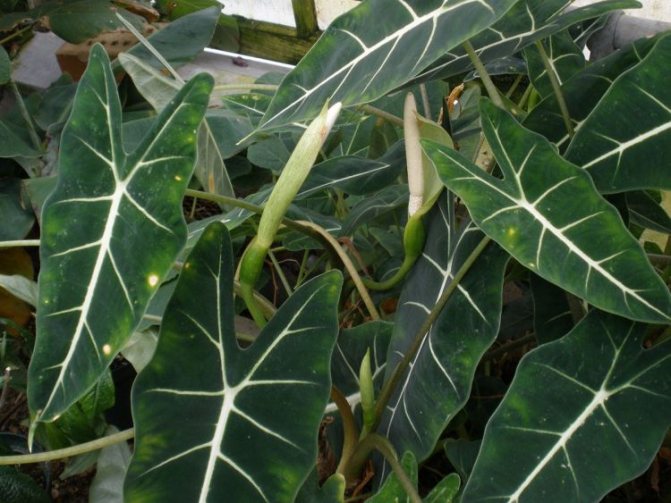

Alokazia - 105 photos of cultivation, types of plants, care and decoration options with a flower
- Aspidistra - tips for planting, care, reproduction and use in the interior (110 photos and videos)
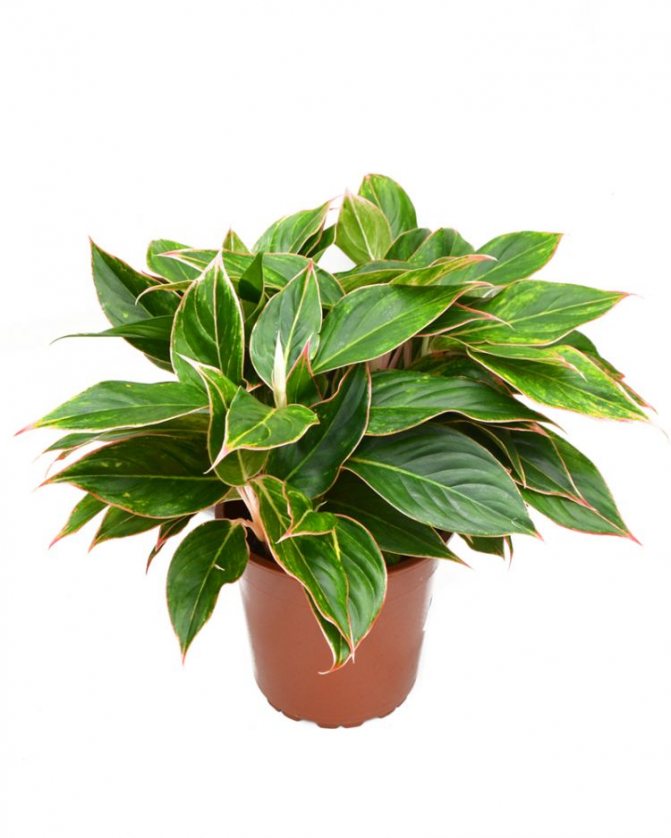

Droplets, brown spots and other problems
Table: maintenance errors and their elimination
| Problem | Cause | Elimination |
| Leaves dry and become brittle. | Too dry and hot indoors. | Transfer the plant to a ventilated area, wipe the leaves with a damp cloth, spray. |
| The edges of the leaves began to turn yellow. | Watering is done with hard chlorinated water. | Defend water before watering for at least a day. |
| The edges of the leaves have become sluggish. | Over or under watering. | Dig in the pot to see if the soil is dry enough for the next watering. |
| Droplets appeared on the leaves. |
|
|
| Leaves lose color, yellow spots appear. | Possible burns from direct sunlight. | Move aglaonema out of direct sun. |
| The leaves began to shrink. | Most likely a lack of nutrients. | Feed the plant. |
| Twisted leaves with brown edges. | Too cold air or drafts. | Move the aglaonema to a warmer, draft-free room. |
Table: diseases and pests of aglaonema
| Problem | Symptoms | Fight and prevention |
| Gray rot | Gray, sometimes brown spots appear on the leaves and stem, soft to the touch. They spread quickly throughout the plant. |
|
| Rust | Fungal disease, in which orange velvet pads appear on the underside of the leaf, and golden spots on the top. | Remove the affected parts of the flower and pollinate the plant with ground sulfur. |
| Mealybug | Leaves bend, dry and fall off. White, fluffy, cotton-like pests can be seen on stems, leaves and in their axils. | Actellik, Fitoverm, Fazol - apply strictly according to the instructions, using protective measures (gloves, gauze bandage). |
| Aphid | Leaves curl, dry, fall off. Aphids are located on the lower part of the leaf and are clearly visible. |
|
| Spider mite | The lower part of the leaf is covered with thin threads resembling a cobweb with whitish dots. The mite sucks the juices out of the plant. |
|
| Thrips | Dry spots or streaks appear on the leaves. The sheet deforms and falls off. | Remove the topsoil to a depth of 3-5 cm, wipe the aglaonema with soapy water. After 4–5 hours, sprinkle with Fitoverm. |
| Whitefly | The lower leaves are covered with a sticky coating. Small white insects living under the leaves are visually visible. |
|
| Shield | Brown tubercles on leaves and stem of aglaonema. Scale larvae can attract black fungus. | The scabbard is removed mechanically, with a damp cloth soaked in a mild soapy solution. Every 3-4 days, the procedure must be repeated until the scabbard disappears completely. |
Transplanting and rooting aglaonema at home
Transplanting young aglaonema is a procedure that must be performed to obtain optimal results such as decorative bush, variegated foliage and long flowering. The reasons are quite simple and straightforward. In the first years of life, the flower actively grows over with new stems, buds, its root system increases and it outgrows the pot. If nothing is done, then the reverse process will begin and the plant will wither. Therefore, transplanting for young plants should be carried out every year, and then every 3 years.
It is necessary to transplant exquisite aglaonema at home in the springtime. During this period, the plant is in an active growth phase, and it is more clearly seen that the capacity is too small for the rhizome.
To begin with, before the "migration" of the ornamental shrub, it is necessary to moisten the soil, which will facilitate its removal from the pot. The new container should be several centimeters larger than the previous one. It is worth putting drainage on its bottom and slightly filling it with moistened soil. And only after such actions, place the plant with carefully cleaned roots from the soil.
The next step is to add a medium to fill the pot and completely cover the root system. To ensure the complete rooting of the transplanted aglaonema in the new soil, it is advisable to leave it without watering for a couple of days. Such a procedure can be painful for the flower, so in the first days it is important to pay special attention to it and surround it with care.
Beneficial features
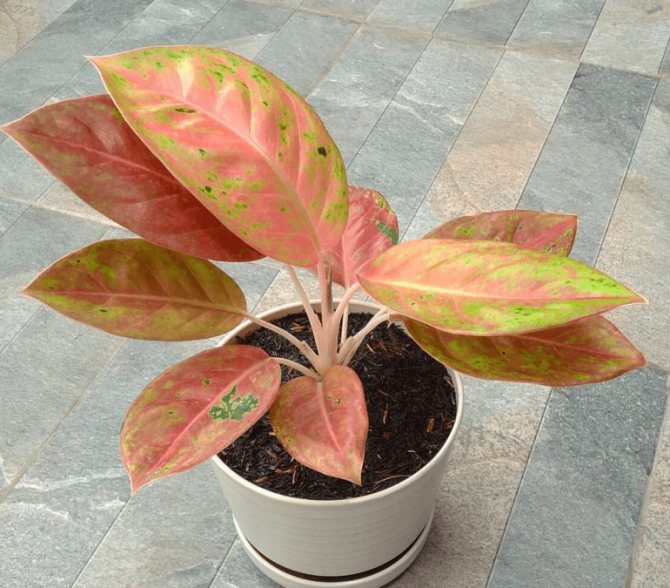

Havehumidifies the air in the room. Reduces the level of toxic substances released by new furniture and gas stoves. Some species disinfect the air by removing anaerobic bacteria. During the period of intensive growth, the flower releases air ions, which cause a charge of vivacity, increasing resistance to stress.
What indoor plants are good for the home?
Some of them are known to many since childhood, such as aloe and Kalanchoe, with which our mothers and grandmothers treated us for a cold or a cold. The plants listed below are home healers: they purify the air, they can be used for recipes of traditional medicine, they release components into the atmosphere that normalize the emotional background.
↑
Houseplants useful for home
Lemon is very decorative - a small tree with bright fruits looks just charming, plus it is very useful. I think everyone knows about the healing properties of lemon fruits, but its leaves are capable of emitting useful phytoncides, volatile essential oils. Where there is a lemon tree, it is easier to breathe, the mood rises, and brain activity is activated.
Lemon, photo:
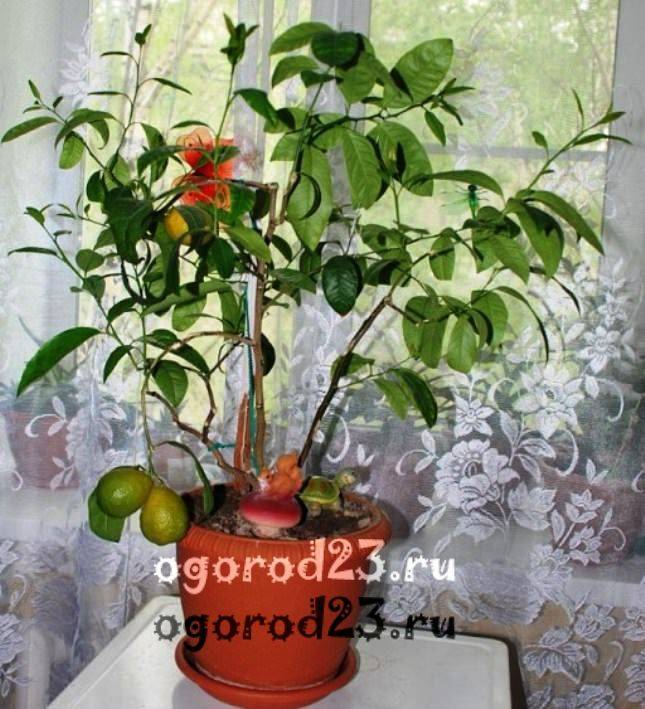

Lemon with fruits
The well-known aloe is incredibly useful, has a wide range of medicinal uses. Aloe is undemanding to care, tolerates long breaks between waterings, and grows quickly. The juice and pulp of its leaves is a real immunomodulator for our body. Aloe has a powerful bactericidal, healing effect, is able to suppress the growth of cancer cells, and activates the vitality of the body. The most common "medicinal" variety is tree aloe, but striped aloe and awesome aloe are poisonous. Most of the useful components contain plants that are already 3 years old.
Aloe, photo:
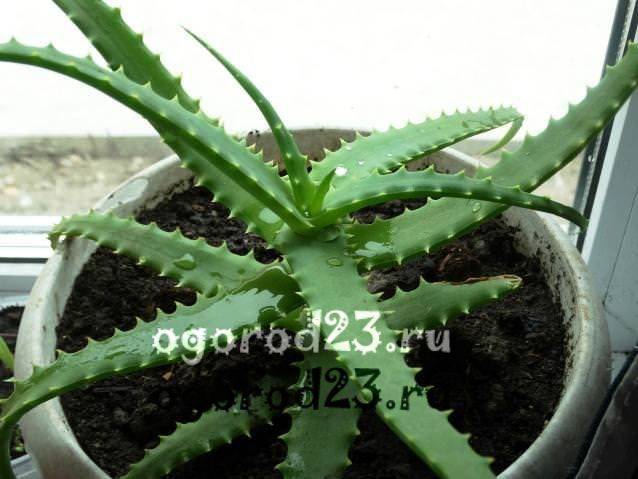

Aloe arborescens Miller or agave
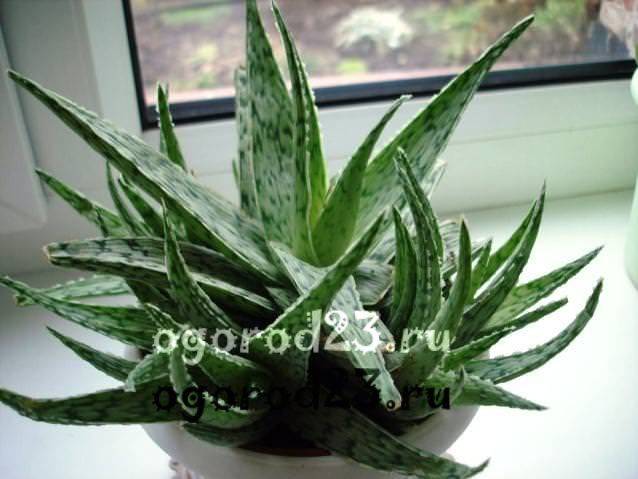

Aloe Vera (A. vera L)
Pelargonium is a close relative of geranium, they are often confused, although it is geranium that is more related to garden representatives, and pelargonium is closer to domestic ones. One way or another, more often all types of pelargonium are called geraniums. This flower is very popular, which prompts breeders to develop many new varieties. You should be aware that certain varieties of pelargonium can be poisonous! Therefore, for home breeding, choose safe varieties (hybrids, zonal pelargonium, large-flowered) that refresh, purify the atmosphere, and destroy pathogenic bacteria. Moths, mosquitoes, flies do not like pelargonium very much, they "run" from the room where it is located. If we consider indoor plants, signs associated with them, then pink pelargonium can be considered a magnet for love relationships. White pelargonium is recommended for those who dream of a child.
Pelargonium, photo:
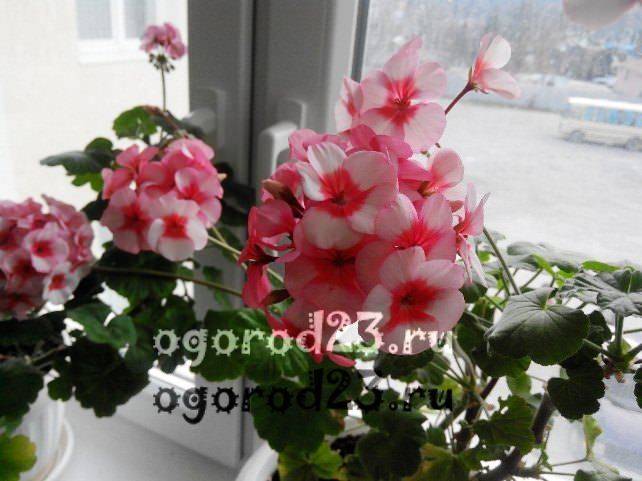

Pelargonium (geranium)
Spathiphyllum is an elegant, sophisticated flower that brings happiness, helping women to meet their love, popularly called “female happiness”. It purifies the air at home, suppresses harmful bacteria, and has a detrimental effect on mold spores, if such a problem exists. Spathiphyllum actively releases oxygen at nightfall. The genus Spathiphyllum is houseplants that bring love, family happiness.
Spathiphyllum, photo:
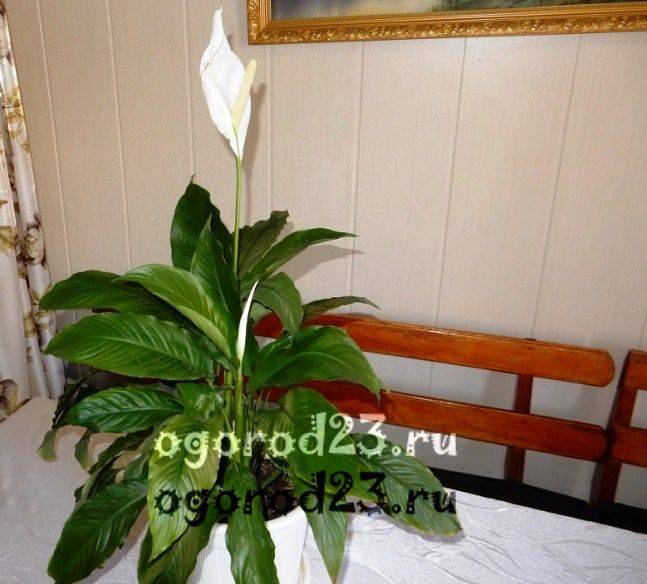

Spathiphyllum
Nephrolepis - one of the most attractive domestic ferns, also has air-purifying properties, "absorbs" radiation from a TV or computer. Nephrolepis releases oxygen, biologically active compounds, it is easier to breathe with it in the room, the mood rises.
Nephrolepis, photo:
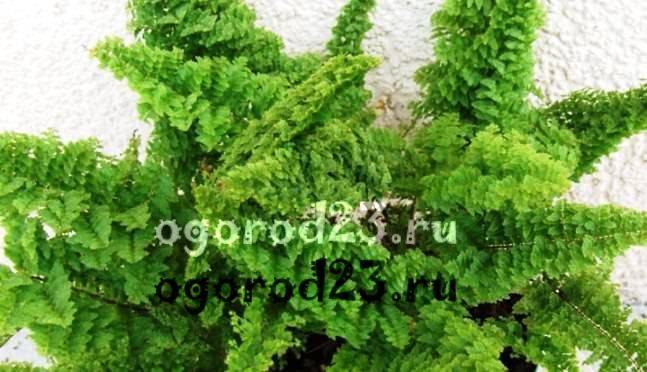

Nephrolepis
Kalanchoe is another home healer called indoor ginseng or tree of life. It is unpretentious, with the onset of summer it is recommended to take it out into the fresh air more often. The scope (of drugs based on it) of Kalanchoe is incredibly wide - dentistry, surgery, gynecology, etc. Kalanchoe has a hemostatic, wound healing, anti-burn, antimicrobial, antiviral effect.
Kalanchoe, photo:
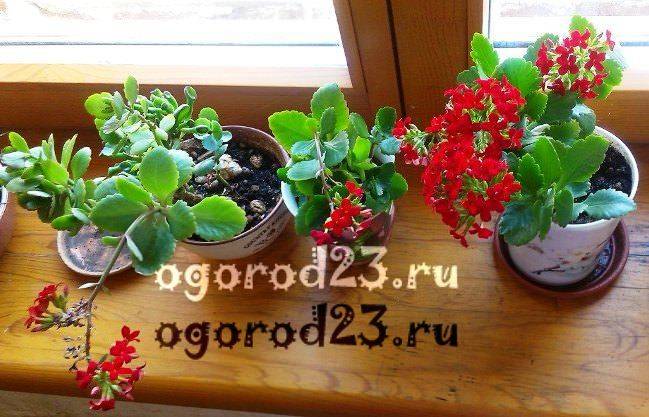

Kalanchoe
Begonia is useful, namely the decorative-deciduous group of plants, which saturate the atmosphere with phytoncides, humidify the air, and protect it from dust. Please note that the Begonia Eternal Blossom variety is toxic, and so are its hybrids. The rest of indoor begonias are able to suppress staphylococcus and streptococcus bacilli, various chemical constituents of the air. Ornamental leafy begonias are indoor plants that purify the air.
Begonia, photo:


Begonia
Chlorophytum is unpretentious, grows, develops in any light, loves moisture. It also has powerful, air-purifying properties, and if, during transplanting, you add activated carbon to its soil mixture, then the useful qualities of this green inhabitant will only become stronger. This home flower is able to stop the poisonous secretions of combustion products. Chlorophytum species such as indoor Cape, Crested, Bonnie, Winged are the best indoor flowers that purify the air.
Chlorophytum, photo:
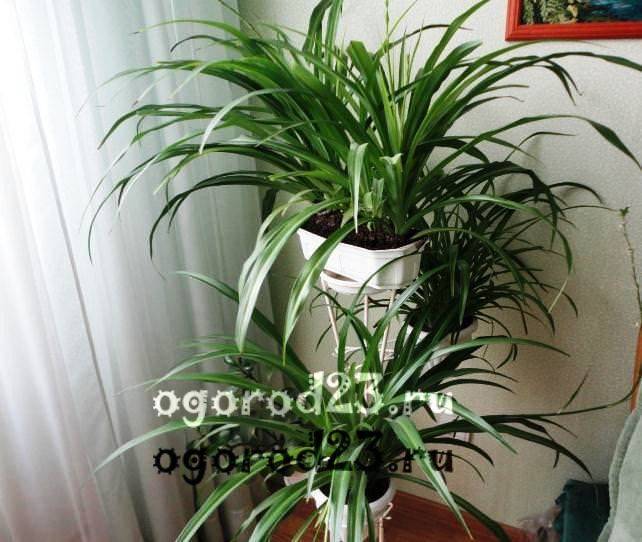

Chlorophytum
In addition to their medicinal, decorative qualities, many indoor flowers carry a certain energetic message, at least that's what many people think. Many signs have come to us from time immemorial, believe them or not - our personal choice, but it is worth paying attention.
↑
What kind of indoor plants can you keep in your bedroom or nursery?
Your sleep, well-being and, finally, family relationships depend on the atmosphere in the bedroom. You can not place poisonous representatives in the bedroom - those that throw toxic spores into the air or provoke allergies.
Opt for chlorophytum, laurel, potted rosemary or lavender.
Purifies the air, releases oxygen from geraniums, camellias, spathiphyllum, begonia, Kalanchoe, aloe, uzambara violets. These indoor plants for the bedroom are really able to relieve stress after a hard day, remove insomnia, and calm the nervous system.
But monsters, ferns, ficuses, strong-smelling lilies, gardenias, oleanders should not be settled where you sleep.
It is also not recommended to have too many flower pots in one room - all kinds of fungi grow faster in a humid environment (soil).
If people suffer from asthma or allergies, then, of course, it is better not to place flowers in the bedroom at all.
Indoor plants for a children's room are the same phytoncides that emit useful components that purify the air, have a detrimental effect on bacteria and viruses. For a nursery, it is better to choose unpretentious flowers that are resistant to "injuries" (breaking off leaves, breaking stems).Children, as you know, are still those fidgets, so some complex or capricious flower is unlikely to take root if it becomes the object of close attention of young researchers.
For a children's room, hibiscus, lemon, myrtle, chlorophyllum, tangerine, balsam, hippeastrum, eucalyptus, phalaenopsis are perfect. These green inhabitants perfectly purify the air, produce oxygen, fight toxins, and all kinds of bacteria.
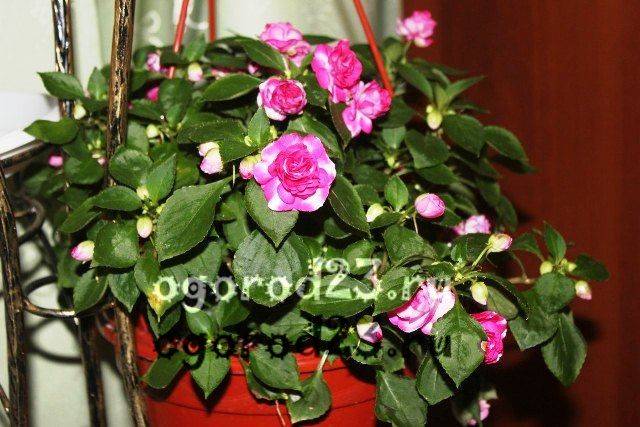

Wahler's Balsam
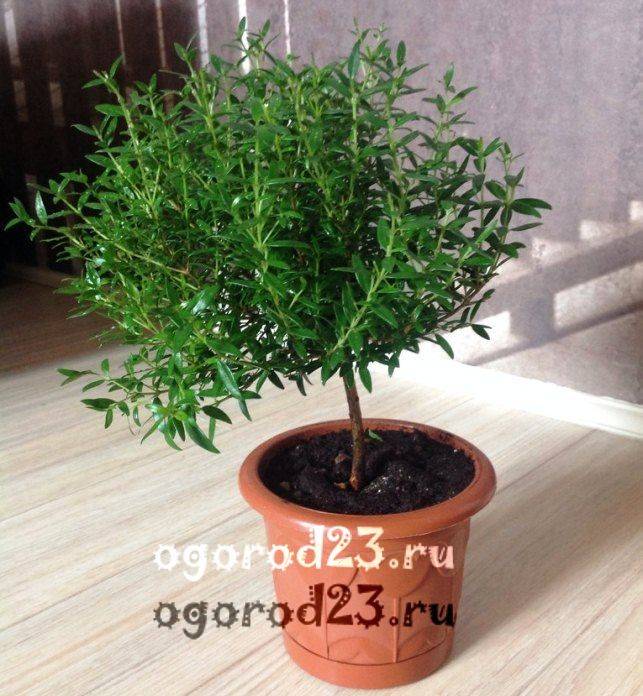

Myrtle
↑
Not only beauty, but also benefit!
The plant has the happy trait of creating the impression of thickets at a young age. It becomes very cozy around her.
At maturity, some species reach one and a half meters and turn into a kind of domestic tree.
This is the most shade-tolerant plant. It can live in the back of the room, in the bathroom and even in the hallway.
In some cases, the plant smooths out the harm from fumes and dust from plastic and wood slabs, as well as from the emissions of working gas stoves. Cleans the air from formaldehyde and benzene. This is a rare quality that is highly prized.
Aglaonema fights diseases such as scarlet fever, erysipelas, osteomyelitis, endocarditis, and other streptococcal infections. Facilitates healing from wounds. In such cases, the flower can be placed next to the patient's bed.
The plant helps to resist stress and improves performance.
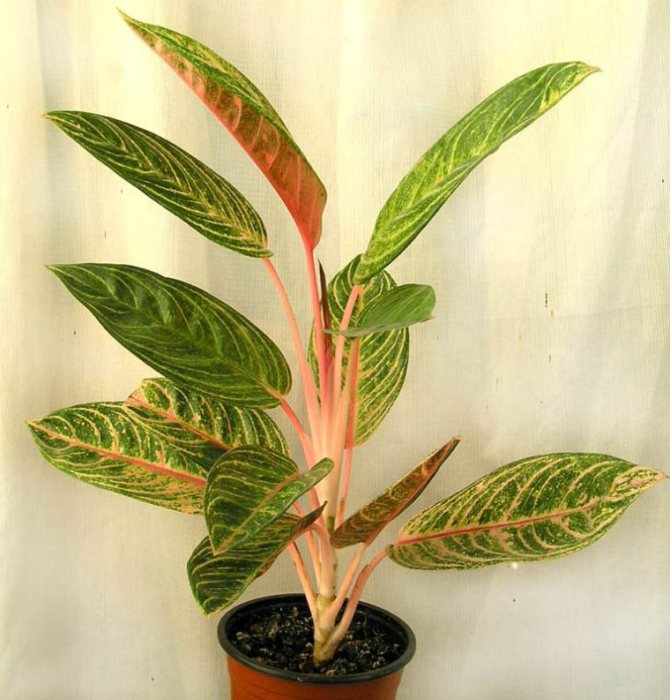

Planting shoots of aglaonema
The creation of greenhouses requires from flower growers the experience of competent reproduction of an amazing aglaonema in the usual home conditions, which will increase the number of unique representatives of tropical countries.
The most popular breeding methods include these alternatives:
- Lateral shoots with roots.
- Stem cuttings.
- With the help of seeds.
The simplest and most effective technique among experienced florists is reproduction using lateral shoots with root shoots, that is, dividing the bush.
The only thing worth knowing when using this method is to carefully divide the plant. It is common for the aglaonema bush to grow and form young shoots that can independently provide themselves with all the necessary life processes. Such potential seedlings can be separated and planted in separate pots. An important requirement of this method is to choose the right sprout. It should have 5-6 healthy leaves and a mature rhizome.
Planting shoots of aglaonema should be carried out at a warm temperature not lower than + 20 ° C. If necessary, you can cover young plants with a glass jar or foil to create a mini-greenhouse effect.
This "trick" will speed up adaptation and germination of roots in new soil. The active growth of the deciduous crown of young seedlings depends on regular watering and abundant spraying.
Florist reviews
I love flowers, but this one is in my top ten favorites! Pluses: very beautiful. Disadvantages: a little whimsical to care for, poisonous juice and berries. Since aglaonema are shade-tolerant, partial shade is preferable for them, they cannot stand direct sunlight, because this threatens them with leaf burns. The optimum temperature for them is 20–25 ° C. In winter, the temperature should not be lower than + 16-18 ° C; sudden temperature changes should be avoided. Also try to avoid drafts, as they are detrimental to aglaonema. Water the aglaonema abundantly in the spring and summer, and regularly after a day or two in the fall and winter. Like all other plants, it should be watered with soft and warm water. I also add fertilizers to the water for irrigation, so to speak, vitamins for plants, they can be purchased at any flower shop, I water this water once a week. In dry air, aglaonema leaves deform and unfold poorly, so try to humidify the air. If you cannot humidify the air, then you just need to spray the flower regularly.While Aglaonema was young, I transplanted it every spring, and only then it can be done once every 3-5 years. In one magazine I read that with good care, aglaonema can even bloom, but this has not happened for me yet. I hope that soon my flower will thank me for its careful care.
Agata Kristi
The flower looks pretty. My aglaonema is young, she is only three years old. The leaves are beautiful, with white spots, like some kind of pattern. It stands on a windowsill on the southeast side. It does not like direct sunlight, it burns in the summer, and I have to move it to the north side. He loves water, I can tell you, not just from the tap, but soft, room temperature. I pamper him once a month with a shower (spray). If someone wanted such a flower for themselves, be patient. This flower grows slowly and needs feeding. I do this every two months, that's enough. This flower has its own sorrows. Aglaonema has an enemy - a mealybug or root mealybug, so every six months I spray it with a special solution (sold in specialized stores). I love this flower. And even if it does not have bright blooms and it is not so fragrant. It is very pleasant with its interesting appearance, branched, with openwork leaves. And there is also a benefit from it, it is able to resist pathogens (streptococci), and this is an important factor. This flower pleases my eyes every day!
anastasiyaklass
A very interesting plant. The color of the leaf is variegated and resembles a dieffenbachia leaf. The main difference between Aglaonema is that it does not have a trunk as such, but in shape it looks more like a bush. It blooms in the spring. The flower resembles a spathiphyllum flower, only smaller. There are many types. The color of the leaves can be from completely green to almost white, very beautiful species with red blotches. I took my beauty from a friend with a small appendage. All reference books say that Aglaonema grows very slowly, is hygrophilous, loves shade. At the beginning I did so, the result was sad! She began to ache, the lower leaves turn yellow and fall off, and in 2 months she did not release a single new leaf, she only threw off 4. Now I don't trust reference books! I transplanted it into a low pot; moved it to the windowsill, where the sun hits after dinner and is not very bright; I water it 2 times a week, the main thing is that the soil does not dry out completely; I spray once every 2-3 days; I feed with liquid fertilizer once every 2 weeks. Now she releases 1.5 sheets every month, that is, 1 sheet opens completely, and the second just starts to open. I would not say that it is slow. Recently, a new appendage appeared, and his son accidentally broke it. We put him in a separate pot. To be honest, I didn't think it would take root. And our process took and took root! It turns out that Aglaonema reproduces very easily, you don't have to wait for the cutting to take root.
Ilanna
Conditions for growing indoor aglaonems
In many ways, aglaonemas can be called typical Tropicans. For them, you need to select really optimal lighting and temperatures, but at the same time the plants do not impose any non-standard special requirements.
Photophilous and thermophilic, aglaonema do not respond well to any deviations from optimal conditions. It is especially difficult to choose a suitable maintenance regime for the winter, when mistakes can lead to a complete loss of decorativeness. Common green-leaved species aglaonemas are more "tolerant" to low light or temperatures, but varietal plants require strictly optimal conditions for them.
Because of their love for high humidity, aglaonema can be ranked among the plants that are best grown in flower showcases, greenhouses, florariums and tropical gardens. They can actually become a luxurious accent in the company of any moisture-loving blooming or leafy stars, but still more often Aglaonems are used for interior decoration. In order for them to reveal their beauty in living rooms, careful care and careful control of the conditions of their detention are needed.
Lighting and placement in the interior
Beautiful patterns of aglaonem, as well as compactness, density of bushes, are possible only with sufficiently bright lighting.The leaves of this culture are delicate, they cannot stand direct sunlight, so the lighting mode for aglaonema can only be diffused. Even from the morning or evening sun in summer, protective screens should be installed.
With a decrease in light intensity and daylight hours, aglaonema should be moved to the lightest window sills, trying to maintain the lighting level unchanged. Lack of light leads to shrinking, stretching, shedding of leaves.
If possible, additional lighting can be installed for the winter. Some shading can only be tolerated by green-leaved aglaonema, which can be kept even in partial shade throughout the year. But nevertheless, even such aglaonema retain a high decorative effect only in bright light.
The eastern and western windowsills are considered ideal places for aglaonem. But aglaonema doesn't have to be hosted only on them. Possible places in the interior of rooms with southern or numerous windows, near a bright balcony, as well as any location with appropriate artificial lighting, allow you to introduce aglaonema into the design of dining rooms, recreation areas, kitchens, bathrooms or any other room.
Temperature regime and ventilation
Aglaonems are extremely thermophilic cultures. The minimum allowable drop in air and substrate temperature for them is + 18 ° С. The plant will withstand short-term drops to +12 degrees, but not without consequences for the leaves. Hypothermia of the root system is especially dangerous for this plant. But even the heat, despite the usual summer temperatures in tropical forests, Aglaonema does not like.
The plant looks best when the air temperature is stable from +22 to + 23 ° С. Any temperature rise above + 25 ° C must be accompanied by an increase in air humidity. The same temperature both in winter and in summer will allow the aglaonema to maintain a stable decorative effect.
Aglaonema is afraid of temperature changes and any, even small drafts. The plant should not be taken out into fresh air and it is advisable to protect it while airing the rooms.
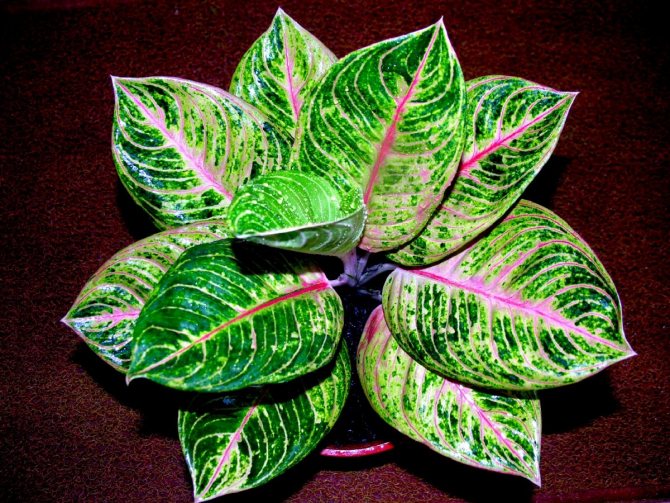

Aglaonema Queen of Siam.
How to make aglaonema more bushy
To keep your specimen more bushy, there are a few rules and tricks you need to follow.
- The pot should be quite tight. First of all, the aglaonema gives all its strength to ensure that its roots fill the entire volume of the pot, and only then the rapid growth of foliage begins.
- To stimulate the growth of additional leaves, you can pinch the upper buds.
- You can cut off shoots at a distance of 5 cm from the ground, root them in water and plant them in a pot next to the mother plant.
There is a choice
Aglaonema is a flower that amazes with a variety of species and varieties, here are the main ones:
- Aglaonema modest... Leaves are leathery, beautiful marsh color. The fruits resemble dogwood. Very shade-tolerant in comparison even with its relatives. These plants are generally easy to care for. But this one is the most unpretentious.
- Painted... May be more than half a meter in height. Dense, at the base, the trunk is strongly bushy. The fruits are red.
- Crete variety... In one sheet, it abundantly combines different colors, but mainly red. Some leaves grow completely dark red. More demanding on light, otherwise the leaves will lose color. The plant is hybrid, with age, the appearance can change.


In the photo, popular types of aglaonema
Care advice
Despite its tropical origin, the flower takes root well at home if properly cared for. Therefore, it is so important to know some of the rules of cultivation.
Lighting and temperature
In order to grow a healthy and flowering plant, it is necessary to create conditions. They should be as similar as possible to the natural environment for aglaonema. When choosing a place where a flower will stand, it should be borne in mind that the sun is contraindicated for some representatives.
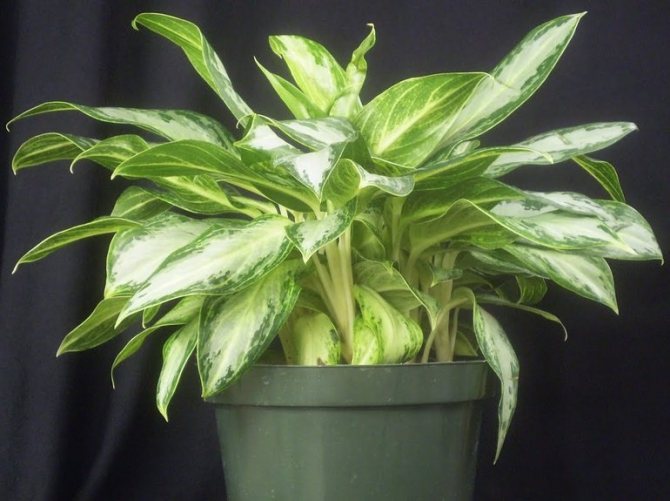

Other species, on the contrary, love bright light, so in winter they have to be illuminated at all. Otherwise, the foliage will fade and the plant will lose its decorative appearance.
It is preferable to put a flowerpot on the east window, but you should carefully monitor that there are no drafts in the room. But the plant needs fresh air, so you need to ventilate the room daily.
As for the temperature regime, the following indicators should be adhered to:
- in summer - from 20 to 25 ° C;
- in winter - from 16 to 18 ° C.
It is also important to avoid sudden changes in temperature. Horse racing adversely affects the flower, which can be stressful. A similar condition often leads to leaf dropping, the appearance of diseases and other troubles.
Watering and humidity
Only soft water is used for irrigation. Ideally, take a well-settled or rainwater one. In addition, it should be at room temperature. During the growing season, the frequency of watering is increased. At this time, the soil is moistened as soon as the top layer dries up.
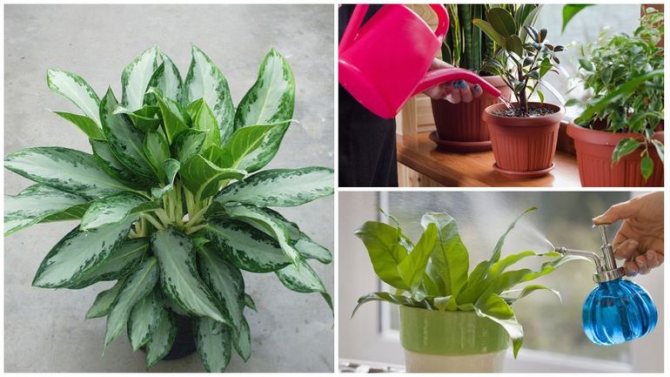

But with the onset of autumn, the procedures are again reduced. Watering is recommended only when the earthy clod dries out by ½ of the volume of the flowerpot. In no case should water stagnation and overflow be allowed - this has an extremely bad effect on the condition and appearance of the aglaonema.
Like any other representative of the tropics, this culture prefers high humidity. Low rates can cause stunted growth, and the leaves will begin to dry, so spraying is carried out on a regular basis.
To maintain moisture, raw expanded clay or pebbles will help - they should be laid out next to the aglaone on a pallet. But the flower pot should not stand in the water, otherwise the root system will rot.
In winter, as a rule, there is no need for such procedures. An exception is flowers that stand in close proximity to radiators or other devices of the heating system.
Fertilization and pruning
Top dressing is carried out only during active growth - with the onset of spring and until the end of the summer period. The procedures are carried out once every 15 days. The composition must include nitrogen and potassium. It is worth abandoning mixtures in which there is lime, since Aglaonema does not like it.
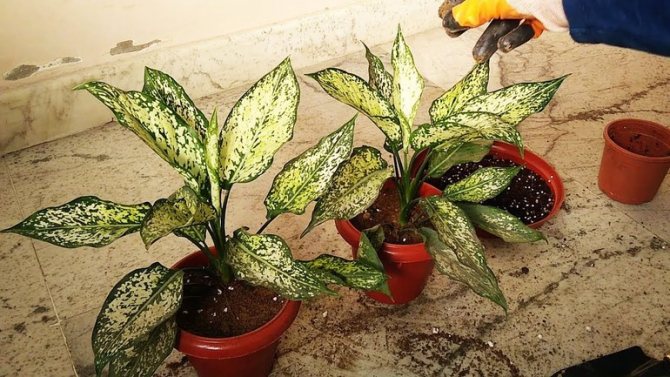

It is best to alternate organic matter with mineral compositions. The optimal concentration is usually indicated in the instructions. Fertilize the flower immediately after watering.
In order for the plant to retain its attractive appearance and decorate the interior, pruning is necessary, and this is especially true for adult aglaonemas. The fact is that their trunk becomes bare with age. The procedure should begin with the preparation of the inventory - the knife or pruner should be treated with alcohol or other disinfecting solution.
Pruning begins with the tops, and only hemp should remain from the removed branches - this rejuvenates the plant. Then you need to sprinkle the cut sites with crushed activated carbon. After some time, young buds will hatch on the tree, which will soon form a beautiful lush crown. For greater bushiness, the upper shoots are pinched.
Transferring to a new pot
You need to transplant a flower immediately after purchase. This is done in order to change the substrate and prevent pests and diseases. Young plants up to three years of age must be transplanted annually, and for older plants once every 3-5 years. The root system must completely braid the earthen lump.
A new flowerpot must be selected in a larger size than the previous one. The optimal substrate for aglaonema is loose and sour. You can purchase ready-made soil or prepare your own nutritional composition, which should include:
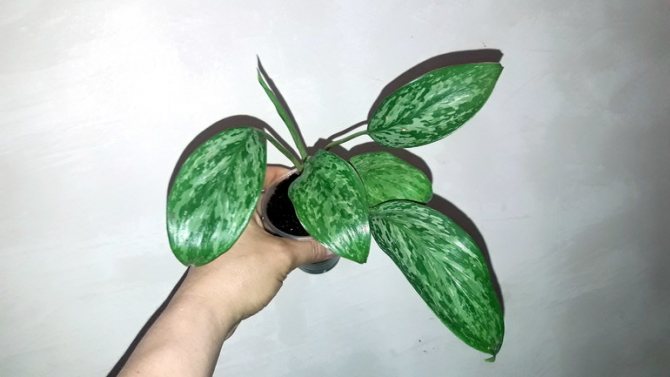

- sheet soil - 6 parts;
- charcoal - 2 parts;
- turf - 1 part;
- sand - 2 parts;
- peat - 2 parts.
In addition, a sufficient amount of drainage must be placed in a flowerpot, which will not allow stagnation of water, and then a layer of earth. After that, you need to get the flower, shake off the old soil from the roots, cut off the rotten roots (if any), straighten the rest and place the plant in the center of the new container, filling it with soil and lightly tamping the surface. Then be sure to water abundantly. Acclimatization can last from 2 to 4 weeks.
Pests that cause agleonema leaves to curl and stains
If graceful leaves are curled on aglaonema, then you should pay attention to the level of humidity in the room. It is the dry atmosphere that can explain such an unpleasant phenomenon.
The recipe for healing is simple and requires more frequent spraying or water procedures using a shower. This bush with a tropical origin will appreciate such efforts and will delight the owners with the splendor of the crown and a rich palette of bright green shades.
However, diseases in an exotic plant can be associated not only with unfavorable living conditions. Sometimes the spots that appear on the leaves of the aglaonema may indicate the presence of parasites, which, by their presence, disrupt vital processes and lead to a gradual wilting. Among the "uninvited guests" it is worth highlighting such pests as:
Spider mite.
Orange aphid.
Mealybug.
The most dangerous insect for an indoor flower is the spider mite, which is almost impossible to notice with the naked eye. However, the harm caused to them is immediately visible. The thin web that envelops the bush gradually leads to yellowness and premature fall of foliage. If you do not take measures to combat it, the green "pet" can wither and die.
The following procedures must be followed as tricks for effectively killing a tick:
- Remove damaged foliage.
- Treat the entire flower with Actellic.
- Systematically ventilate the air in the room.
- Inspect the trunk and foliage on a regular basis.
Orange aphids are small oblong insects that, as a rule, concentrate on young shoots and leaves, sucking juice out of them. As a result, foliage wrinkles, deforms, becomes covered with dark spots and falls off. Such parasites are especially dangerous for buds and inflorescences. For a couple of days after the appearance of "uninvited guests" they twist and die.
The method of dealing with aphids covers simple steps:
- Spray the foliage with a solution of pyrethrum or tobacco.
- In case of significant damage, apply karbofos.
- For prophylaxis, treat with soapy water.
Mealybug is a parasite that often damages various representatives of indoor greenhouses. In aglaonema, such insects reproduce in the axils of the foliage and infect the stems and young succulent shoots. It is not difficult to notice them on the plant, since they are collected in separate areas in whole colonies.
To free the flower from these parasites, the following measures must be taken:
- Remove visible groups of insects with a cloth soaked in soapy water.
- In hard-to-reach places, remove pests with a cotton swab treated with alcohol.
- Cut off badly damaged leaves.
- With a large number of parasites, spray the plant with karbofos.
Such recommendations are highly effective and will help you get rid of pests with ease.
But it is worth remembering that if you provide favorable growing conditions, regularly water and fertilize the soil, monitor the humidity of the air, then pests and diseases are a rare phenomenon in the life of an elegant plant.
Anti-aging pruning
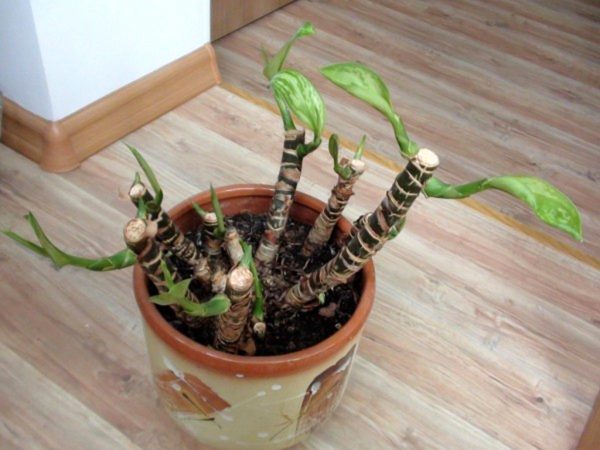

When the aglaonema is old, its trunk will be exposed. This will be a sign that the plant needs anti-aging pruning. Using a sharp knife, carefully cut off the top so that a bare stump remains in the pot.Treat the cut with crushed coal. Continue grooming the hemp and new buds will soon appear on it. After a while, aglaonema will again become a beautiful lush bush.
The cut off part can be used for propagation. We will discuss this below.
How often should a flower be replanted?
While the plant is young, transplant it every spring. The land should be mostly leafy. Tropical forests are deciduous.
So that the soil retains moisture well, but is permeable to air, a little sand and crushed coal are added to it.
Humus is added for nutrient enrichment. Remember to place a layer of pebbles on the bottom of the pot.
In adulthood, the flower matures, its appearance is transformed. The color of the leaves changes tone. Some types of aglonema begin to resemble a bush or even a tree.
Many are not ready for such a transformation, expecting youthful beauty from the plant. You must be able to look at the flower with a different look and provide it with the appropriate conditions.
The plant looks much more beautiful on the floor than on a stand. Remember only pets and small children who might think to taste it. This is dangerous for them.
An adult plant is transplanted every three years.
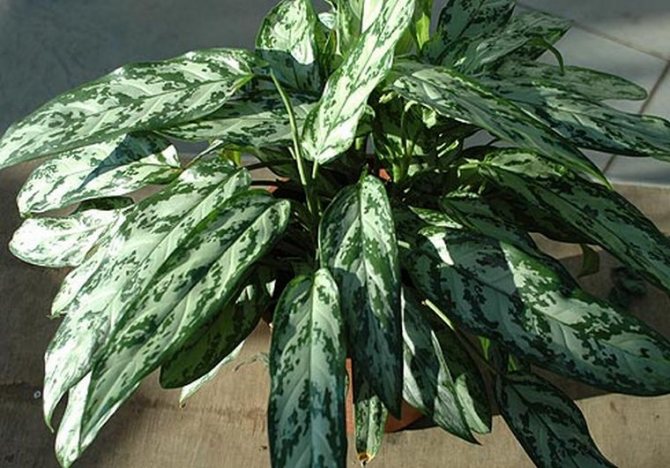

Can I keep it at home?
Aglaonema is a natural air purifier... The leaves of the plant are capable of absorbing compounds such as phenol, benzene, formaldehyde, evaporating from polished or plastic surfaces. In addition, the leaves of the plant are involved in the production of phytoncides that destroy streptococcus.
Based on the above, aglaonema brings many benefits to the home, but there is one deterrent that prevents people from acquiring this plant. It is believed that aglaonema is a poisonous plant.
Important! Aglaonema, like most members of the aroid family, has a very caustic sap, its leaves should never be tasted.
Therefore, to the question "Is it possible to keep aglaonema at home?" there will be an obvious answer: you can, but if there are no small children in the house.
The reasons why leaves turn yellow in aglaonema, and what to do if diseases appear
Despite the unpretentiousness of the living conditions, aglaonema is characterized by diseases that are manifested by such signs as:
- Yellowness of the leaves.
- Twisting sheet plates.
- Drying of the crown.
- Loss of rich foliage colors.
Each of these "ailments" has its own reasons, eliminating which, it is easy to achieve complete healing and the desired results.
The reasons why Aglaonema foliage turns yellow lie in improper watering or in an inappropriate temperature regime. So, if you overdo it with moistening the soil, then soon the first signs of wilting of the leaf plates will be noticeable.
By limiting unnecessary watering, which is one of the main reasons that the leaves of the aglaonema gradually turn yellow, you can save the plant and give it splendor and richness of colors.
Low temperatures can also be a significant prerequisite for wilting of the bush. In such situations, the solution is quite simple, and to the question of what to do when the leaves of the aglaonema turn yellow, the answer is clear - to rearrange it in a warmer room. After a few days, improvements will already be noticeable. At the same time, it is important that there are no drafts or sudden changes in temperature in the room. Since such phenomena also lead to "ailments" and loss of decorativeness.
Direct sunlight may be another explanation of why tropical aglaonema spots and leaves turn yellow. To solve such a problem, the first step is to eliminate the unfavorable factor and remove the pot in partial shade.
Further, it is advisable to cut the damaged sheet plates, since they cannot be restored and only spoil the appearance.
When and how it blooms
How aglaonema blooms, you can rarely see, but with proper care in summer, the plant produces an inflorescence - an ear with discreet small flowers.
Types of flowers
Depending on the cultivar, aglaonema can bloom in thin, cylindrical (5 mm in diameter, 4 cm in length) or thick, clavate (1 cm in diameter, 3 cm in length) flowers.
Flower shapes
Aglaonema inflorescences are pale green, collected in an ear 3 cm long. Inflorescences appear in 1-3 axils of the upper leaves.
Flowering period
Aglaonema blooms from June to August. After 8 months, bright red berries ripen, less often white, oblong, containing one seed each.
Changes in care during flowering
Proper home care will help to make the aglaonema flower bloom: it is enough to prepare a wide and shallow container, observe regular spraying and watering, and maintain a stable temperature.
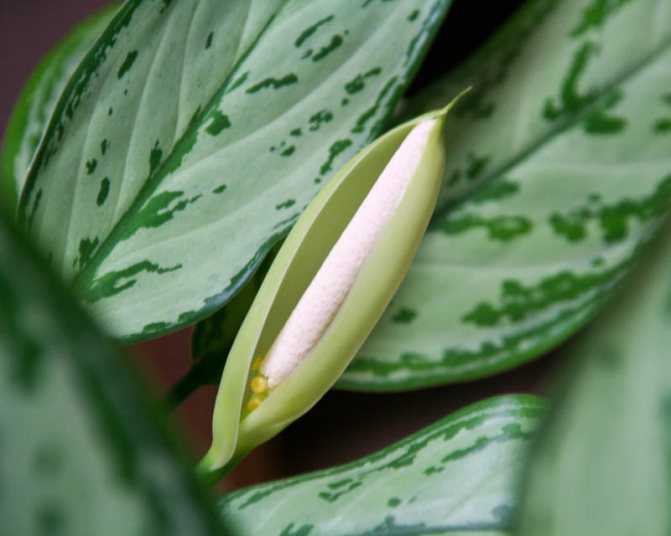

Aglaonema during flowering
Advice. Feeding the plant with bone meal will help speed up flowering.

